

Inauguration sparks mixed response in Iowa
Iowans are divided regarding President Trump’s second term.
Roxy Ekberg Politics Editor roxy.ekberg@dailyiowan.com

President Donald Trump’s second inauguration raised contradictory feelings from residents in the Iowa City area. Some were moved to participate in a national march in protest, while others eagerly awaited the Republican’s return to the Oval Office.
Over a hundred people marched in the Coralville branch of the People’s March as a part of nationwide demonstrations on Saturday.

In solidarity with the larger national protest, the People’s March community members, leaders, and activists marched during freezing temperatures Saturday morning.
The People’s March, known previously as the Women’s March, has taken place every year since 2017. The movement was organized by a coalition of groups with the intent to confront “Trumpism,” according to its website.
Over 98,000 attendees marched at 382 events nationwide on Jan. 18, according to the movement’s website. There were also 79 additional events marked as upcoming.
Co-organizers of the local event, Mary Cohen and Marie Garry, emphasized the importance of
building a strong community and making connections.
“There’s a longing, a great longing, in many of us, given the times that things feel very difficult and challenging, and we need each other,” Garry said. “We need to learn to lift each other up, and singing and creating communities is how we do that.”
Cohen led the group in song at their meeting place in the basement of the Coralville Library. Clapping and singing, the crowd ranged greatly in age. Toddlers bounced on the knees of their parents, and old friends gave warm embraces to newcomers.
Future wavers for GWSS
Students and professionals worry about a UI proposal’s impact.
Kate Perez Senior Reporter news@dailyiowan.com
The University of Iowa’s Department of Gen der, Women’s, and Sexuality Studies celebrated its 50th anniversary in 2024.
In 2025, it may no longer exist as an individual department.
Established in 1974 as the Iowa’s Women’s Studies Program — one of the first in the United States — the program has since progressed to include a wider study of gender and sexuality, including the current social justice major.
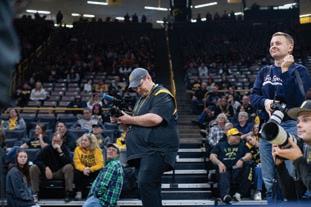
As the spring 2025 semester begins and stu dents start to settle into classes, the University of Iowa will once again propose changes to the UI curriculum offered in the College of Liberal Arts and Sciences. In February, the university will go to the Iowa Board of Regents for approval to create a new School of Social and Cultural Analysis.

The university announced the proposal last month, stating the new school is a part of a “multiyear administrative restructure of the college intended to better serve students and faculty.”
The college received approval from the regents for similar proposals in fall 2024, including cre ating a new School of Earth, Environment, and Sustainability.
The creation of the new school will result in the shifting of operations for many programs and departments within the college, including a new major and a Bachelor of Arts degree offered in Social and Cultural Analysis.
If approved, the Department of American Studies and the Department of Gender, Wom en’s, and Sexuality Studies would both close. The current Bachelor of Arts degrees offered in American Studies and Social Justice would also close. However, all other majors, minors, and certificate programs would move into the new school come fall 2025, including:




Members
•
• Nearly a year after the University of Iowa’s “Cancer in Iowa” report linked alcohol consumption to a greater risk of cancer, United States Surgeon General Vivek Murthy issued a new advisory Friday warning Americans about alcohol consumption risks. Check out our latest coverage at dailyiowan.com.
It’s been two years since the University of Iowa Police Department restructured into Campus Safety. Check out our latest coverage of the partnership at dailyiowan.com.

faculty in sustaining teaching capacity.”

The new Bachelor of Arts degree in Social and Cultural Analysis
The Bachelor of Arts degree in Gender, Women’s, and Sexuality Studies
The African American Studies; American Studies; Gender, Women’s, and Sexuality Studies; Gender, Health, and Healthcare Equity; Latina/o/x Studies; Native American and Indigenous Studies; and Social Justice
minors
The Jewish Studies and Native American and Indigenous Studies certificates
Fewer than 60 students are currently enrolled in the majors of American Studies and Social Justice. The press release states the creation of the new school would simplify the operations of the interconnected departments, as the existing programs have limited faculty and overlapping
Hills Elementary reduced to rubble
Roland Racevskis, College of Liberal Arts and Sciences associate dean for the arts and humanities, said in the release multiple department chairs and directors run the current programs. In the proposed school, abbreviated as SCA, there would be a singular leadership team that oversees the operations of the programs offered, and all faculty would be moved into it.
“This new structure would provide better coordination of curriculum across these related programs, easier pathways for degree completion, and support for interdisciplinary research opportunities,” Racevskis said in the release.
Additionally, the proposed new degree aims to prepare students to go into fields like education, research, public policy, and community engagement, where they have to understand and analyze the world, Cornelia Lang, College of Liberal Arts and Sciences associate dean for undergraduate education, said in the release.
“Students in this major would be able to connect their individual experiences and ideas to larger social contexts,” Lang said. “This would prepare them well for potential careers or grad-
uate work in cultural studies and related fields through highly adaptable skills like analytical thinking, effective communication, and research.” If approved by the regents, the change and the new school will go into effect on July 1 for the 2025-26 academic year along with the new School of Earth, Environment, and Sustainability.
UI students, professionals wary of potential changes
College of Liberal Arts and Sciences Dean Sara Sanders said in the December release the proposed change would help further the foundation the UI has created in Gender, Women’s, and Sexuality Studies while also enhancing the student experience, supporting faculty, and encouraging collaborative research across fields.
“The creation of a School of Social and Cultural Analysis would allow us to build on our considerable legacy in areas that are essential to our mission while creating more sustainable structures and room for innovative new curricula,” Sanders said.

Ethan McLaughlin | The Daily Iowan Hills Elementary is seen being torn down by a demolition crew in Hills, Iowa, on Jan. 15. The
Trump
Illustration by Marandah Mangra-Dutcher | The Daily Iowan
the Iowa City school district’s reason for holding onto the land, since, she said, the district claimed Hills was not a growing community when they decided to close the school.
“In the school board meetings, they were saying Hills is not a growing community, and so that’s why they decided to close it,” she said. “Now they’re saying that’s why they want the land, because Hills is a growing community. Some literally six months later, they changed their mind on what they’re saying. That doesn’t make any sense.”
Another frustration for Hills residents and Volk is the false promise of a total renovation of Hills Elementary before the vote to close it. Volk said several years ago, a bond referendum was passed to improve all schools in the district, and Hills ended up getting no aid or improvements.
A few years later, people in Hills were encouraged to vote for another bond that would put Hills Elementary first on the list for a new school that they never got. Volk said everyone in Hills is still paying the taxes for the bond even though the school and building are now gone.
“When the second bond came out and they knew they needed Hills voters to vote for it, that’s when they came out and said, ‘You’re at the top of the list. You’re the first project we’re going to do,’” Volk said.
However, the loss of the building and the school has not had a dramatic impact on the community. Hills Mayor Tim Kemp said it was no surprise the district would tear the building down after it closed, and the town had no interest in keeping the building.
“Obviously, losing a school for a community or even a neighborhood is kind of a traumatic thing, but it hasn’t impacted the town,” Kemp said. “There’s not been a mass exodus of people, and I don’t anticipate there will be. [It’s] certainly a nice thing to have a neighborhood school in the community, but we have many other fine things in the community that people want to live here for.”
Kemp said the transition from Hills to Alexander Elementary has also been smooth from what he’s heard.
“The kids were going to be bused starting in sixth grade to middle school anyway, so now they’re just getting bused a few years earlier,” he said. “[It’s] certainly nice that they all could transition together, so they had their existing

friendships and certainly made friendships with students at Alexander since they’ve been there.”
Alexander Elementary Principal Katie Thompson said she and the other faculty have made many efforts to welcome the roughly 100 new students from Hills and help them through the transition. Last spring, before Hills closed, Thompson visited the school to provide kids a familiar face and to get to know her new students. Alexander also hosted a field trip for all the kids at Hills to tour their new school and meet their new classmates and teachers.
“We really focused on community building this fall and honored a lot of the emotions that were there with this group of students and their families,” Thompson said. “We did some intentional work with our students and our staff this fall to prepare everyone to go back to the roots of a strong community because the reality is that we merged a really strong community with another strong community.”
Thompson also said Alexander has a different theme for every school year, and this school year’s theme is “Ignite Your Excellence,” with
the school mascot, Archie the Falcon, holding up a lightning bolt as a nod to the former Hills Lightning Bolts.
One of the main concerns expressed by Hills families when the district board was voting on closing the school was Hills’ large population of students in the district’s English Language Learners program. However, Thompson said Alexander now has seven ELL teachers — the highest number in the district — and the number of students in the program has increased by 7 percent since last school year.
Another concern for Hills parents was larger class sizes and the much larger building, but Thompson said with the transfer of many teachers and staff from Hills, the school has been able to maintain an average class size of 20 students.
“It was really important to our Hills families to keep those small, impactful connections with all the students in our school, and I think that we’re still able to obtain that even with the larger number of students,” she said. “We work really hard to create those strong learning communities in each of our individual classrooms.”
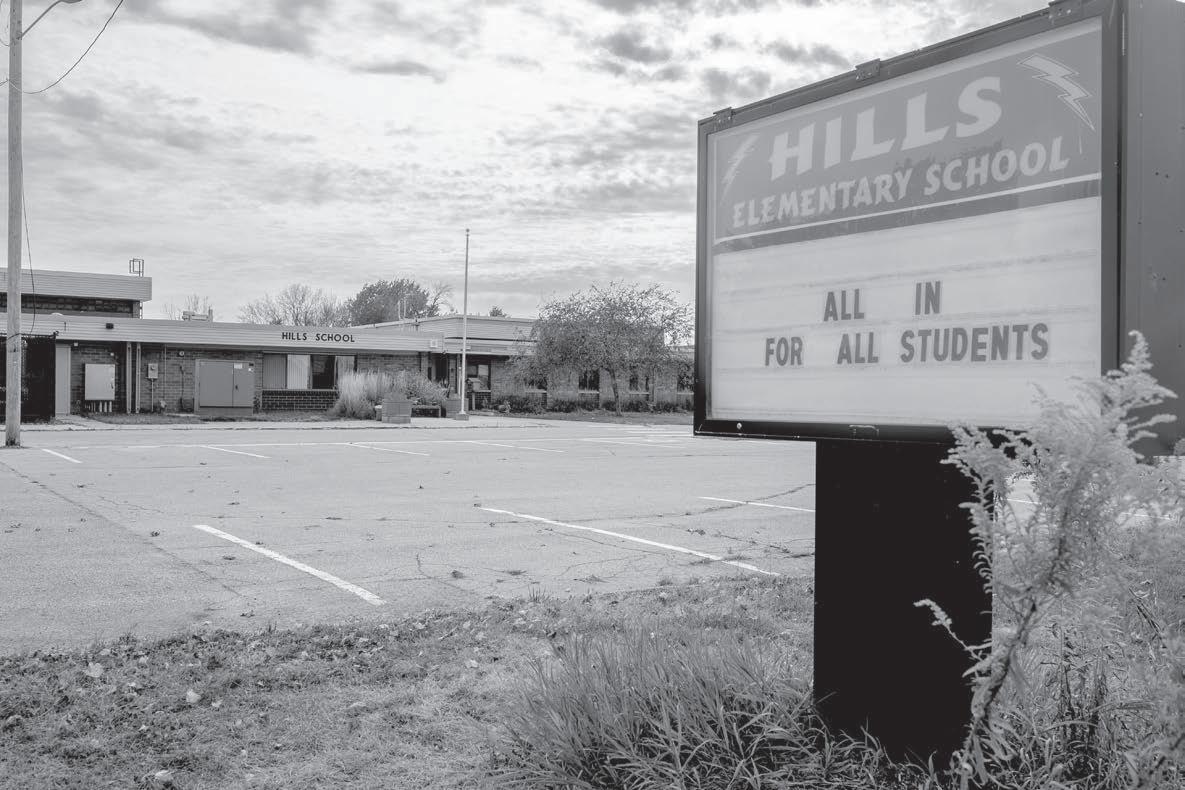
close
JoCo nonprofits work to offer business grants
$500,000 of ARPA funds will go to
Evan Watson Assistant News Editor evan.watson@dailyiowan.com
As the deadline approaches for Johnson County to spend its remaining American Rescue Plan dollars, the county is pledging $500,000 toward small businesses.
The grant program, officially called the Underestimated Small Business Grant initiative, offers $3,500 to $20,000 of reserve American Rescue Plan Act funds to local businesses for business assistance and education, according to a Greater Iowa City Inc. press release.
The funds will be dispersed over three rounds set to occur in 2025. In 2021, Johnson County received $29 million in funding and was required to use or pledge the entirety of those funds by December 2024. The first round opened on Jan. 1 and will close at the end of the month, according to the release.
The program is designed to address two categories of support, according to the release.One category is operational support, which is dedicated to costs like payroll and rent. The second category is classified as storefront improvements, which will fund interior and exterior upgrades to businesses.
The program is a com-
bination of efforts by three Johnson County organizations: Greater Iowa City Inc., the South of 6 Business District, and the Community Foundation of Johnson County.
Greater Iowa City Inc. Director of Marketing and Communications Jesse Wallace said in the release that the grant program is allowing three organizations to share resources to help businesses in the area.
“This grant opportunity exemplifies the strength of collaboration,” he said in the release. “We are proud to partner with South of 6 and the Community Foundation of Johnson County to bring meaningful support to our small business community.”
Three information sessions are available to help applicants during January. These sessions offer assistance in applying electronically to be considered for the grant awards.
Originally, the grant money was dispersed to an out-of-state organization that answered the county’s request for proposals. However, that organization had “too much leaning towards staff support,” South of 6 Executive Director Maurice Davis said. The county opened up another request for proposals as a result, hoping to disperse the funds locally to organizations that needed them more. Greater
Iowa City Inc., South of 6, and the Community Foundation of Johnson County came together to make a combined proposal.
A major goal of the grant program is to provide business assistance to businesses in the South of 6 area, which is the area Davis represents on the south side of Highway 6 in Iowa City. He said it is classified as a specific business improvement district.
“My job is to try to help create an environment that allows those businesses to be successful,” he said.
Davis said a part of what the program is designed to assist with is traditionally underrepresented businesses that have barriers to receiving necessary support.
“Everything that we’re doing is trying to look at what the normal barriers for underrepresented businesses are and asking how we can provide resources,” he said.
Davis could not share information on current applicants or the selection process.
Ellie Moore, vice president of community impact and outreach at Community Foundation of Johnson County, said the trifecta efforts between the organizations are benefitted by their organization, which acts as a nonprofit for nonprofits, so to speak.
“We exist to serve other
nonprofits,” Moore said.
“We have a charitable giving bank. We hold funds for donors and work one-on-one with them to figure out where their charitable donations should be going.”
Moore said the grant program’s benefits and what other programs have done historically is provide small but substantial benefits to put businesses in a better financial plane.
“This kind of short, seedgrader influx of dollars can put you over the edge and get you into this space to succeed,” she said.
Moore said the most remarkable part of the program is the collaboration between three organizations. She said Greater
Iowa City Inc. has technical development knowledge, South of 6 works directly with minority business owners and has strong business coaching offerings, and the Community Foundation can offer software, systems, and grant experience.
“We all have different skills and resources, we might as well get them together,” she said.
She said going forward, a combination of resources is something she would like to see to create a stronger business environment in Iowa City.
“Now we have a model for the future,” Moore said.
“So, there’s something else that comes up that we can work out together.”



Ethan McLaughlin | The Daily Iowan Hills Elementary is seen being torn down by a demolition crew in Hills, Iowa on Wednesday, Jan 15. Hills first opened to the public in 1965.
Emily Nyberg | The Daily Iowan
Hills Elementary School is seen in Iowa City on Oct. 28, 2024. The Iowa City Community School District Board of Directors voted unanimously in March 2024 to
the school.
Jeneane Beck, UI assistant vice president for external relations, added in an email to The Daily Iowan that all associated courses would also be moved into the new school.
Additionally, UI Gender, Women’s, and Sexuality Studies Department Chair Hyaeweol Choi wrote in an email to students that was later shared with the DI, students currently majoring in social justice will continue to be supported by the department as they complete their degrees.
Some UI students, however, are concerned about how these changes could impact the future of the field of study. Madison Bruce, a fourth-year UI student majoring in Gender, Women’s, and Sexuality Studies, said her experience in the department has helped her develop critical thinking and analytical skills that help her understand the world.
Bruce worries that, if passed, the changes could condense or limit the information currently available for students to learn. Each program has different histories and underlying theories that guide it, and she is concerned those could be lost in the new school or major.
“I am just questioning, what does it mean to have these all combined into one program of study? Like, are there going to be concentrations within that? So, I’m curious to see what that actually looks like in practice,” Bruce said.
With plans to graduate in May, Bruce also worries about how a new school and the closing of the well-known Department of Gender, Women’s, and Sexuality Studies could impact her in the job market.
“My resume and my history will always say that I graduated with a B.A. in Gender, Women’s, and Sexuality Studies from University of Iowa. And if any people look into that, they’d see that program is gone. That program doesn’t exist,” Bruce said.
Bruce has also recruited prospective students for the department in the past during Hawkeye Visit Days and worries the newness of the school will not interest students like the current program can.
“Even if this change in structure is just a change in name, which I feel like might be the sort of reasoning behind it, a change in name will still affect the way that the department runs, and it also will really affect the way that we draw in new students,” Bruce said.
Katie Henry, a UI third-year student minoring in Gender, Women’s, and Sexuality Studies, is also disappointed with the proposal. Henry said she was initially confused about what the changes would mean for her ability to complete the minor. She added that she hopes the university would want to promote diversity and inclusion through these areas of study.
“Just the idea of condensing so many of these amazing fields of study that are so important to so many people makes me really sad because it just feels like the university is trying to discredit these [areas of study],” Henry said.
Nick Davis, associate professor and director of the Gender & Sexuality Studies Program at Northwestern University, is also worried about the ripple effects of closing the departments on the larger field of study. Davis said in an interview with the DI that other universities, including the University of California, Santa Cruz, have made similar closures in recent months.
“I think there’s plenty of concern to go around … This closure and its contexts, and the one at UC Santa Cruz and some others, are amplifying, I think, a collective nervousness that did already exist,” Davis said.
While the proposal can create concern and uncertainty for the future of the field of study, Davis added that it does not necessarily have to have a negative impact. Overall, the decision of the program’s future should be a collective one, aimed at aiding both students and faculty. In his role at Northwestern University, Davis said he often tells colleagues and students that gender and sexuality studies is a language department. The skills learned in the study allow people to discuss many different topics, including the changes in the field today and what might come of closures of programs like the UI’s.
“I think a lot of Americans speak only one language, and we’re happy when we acquire even a second one, and being able to talk articulately and confidently and with nuance about gender and sexuality, feeling comfortable with terminologies, understanding how things sound the same are actually different is a huge asset, whatever you’re going to go on to do,” Davis said.
With many humanities programs across the country facing challenges such as budget, enrollment, and political threats, however, Davis said liberal arts and social sciences as a whole could be seeing a time of unpredictability.
“Campus, professional, state, and national politics are in such chaos and uncertainty and concern in these areas that it’s impossible not to be projecting at least the chance that this represents a real retrenchment in an important field that students care about,” Davis said. “It might not be true, and I hope it’s not, but you cannot blame anybody for asking that question.”
UI proposal draws political attention
Among other worries of UI stakeholders is that the decision is connected to the recent push by the regents to eliminate diversity, equity, and inclusion efforts at Iowa’s three public universities, which includes the UI. If approved, the proposal would go into effect on the same day as Iowa Code Chapter 261J, which builds upon Senate File 2435, the law prohibiting any DEI office or employment of staff tasked with duties of a DEI office, the requirement of anyone to provide a DEI statement, and the preferential consideration to anyone on DEI principles. Iowa Rep. Taylor Collins, R-Mediapolis, posted the word “winning” on the social media platform X, formerly known as Twitter, as a response to the news of the potential closure of the departments on Dec. 23, 2024. Since then, Rep. Collins has pushed for the regents to reject the UI’s proposal and eliminate the program completely via a letter written with Sen. Lynn Evans, R-Aurelia.

Evans told the DI the goal behind the letter was to urge the regents to evaluate all programs at Iowa’s public universities. Evans said the regents should consider if programs are meeting not just the needs of the students but the needs of Iowans.
“The letter was to encourage them to take a deep dive and a deep look into this before approving anything and see how that’s going to benefit Iowa taxpayers,” Evans said.
Evans added that he thinks the discussion around a potential new school and the department closures ties into the topic of DEI on the surface.
“That’s why we want the Board of Regents to pump the brakes, not necessarily just approve this upon recommendation in February so that the Board of Regents is assured that they’re aligning with what the intent of last year’s legislation was,” he said.
This vocal support of the closing of the program from politicians is what worries Elisa Burba, a UI fourth-year
minoring in Gender, Women’s, and Sexuality Studies. After seeing Rep. Collins’ reaction, Burba worries the proposal is political alongside being beneficial for the UI.
“I don’t think these are histories that need to be more difficult to find. I think these are stories and communities that need to be uplifted more, and I would hope that the new school would be able to do that,” Burba said.
Burba said the changes to higher education, especially in DEI regulation and restriction, make her feel ominous about the future of Gender, Women’s, and Sexuality Studies in the state.
“Just the way that you see education kind of moving in Iowa in particular, and conversations surrounding what should and shouldn’t be taught in the state, it definitely doesn’t make you have a positive outlook for this change,” Burba said. “There’s a precedent for trying to continue to marginalize these stories, and it’s one that I worry that the Board of Regents would continue.”


Ethan McLaughlin | The Daily Iowan
The board of regents talk about future building plans during a board meeting at the Iowa State Alumni Building in Ames on Wednesday, Sept. 18, 2024. Next month, the university will go to the regents for approval to create a new School of Social and Cultural Analysis which would shift many programs within the university.
New year, exact same US
Terrorist attacks and mass shootings remind us the tragedy of what it means to live in America.
Just World Theory:
the fallacy that is anything but


Shots fired. People murdered. And the message is clear for Americans: The unrest has only begun. For Americans, 2025 started with the same violence and destruction as usual — if not more.
When 14 people were massacred in New Orleans in a terrorist attack on the first day of the year, we thought it couldn’t get worse. On the same day, a cybertruck exploded in front of a Trump hotel in Las Vegas — a deliberate attack orchestrated by an active U.S. military sergeant. These attacks, violent and brazen, were only a glimpse of what was to come.
Within the first few days of the new year, there were six mass shootings, four of which occurred on Jan. 1. A shooting in New York left 10 people injured. Another shooting in a small town in Illinois left five people wounded. But with the first two attacks dominating the news cycle, the shootings went largely unnoticed by both the public and the media. This marks a troubling trend in America: a growing desensitization to violence. And what’s worse is we are armed.
Yet, the problem isn’t just the guns or the weapons — it’s the environment.
In America, there are as many firearms as there are citizens. But it is not just the sheer number of weapons that
Who knew that thinking the world is fair made it less equal for everyone?

James McCurtis Opinions Columnist opinions@dailyiowan.com
“The world isn’t a fair place” is a phrase that has been used in the media and everyday conversation for a long time, but human nature tells us something different. In my sociology class, we learned about something called the just-world fallacy.
The just-world fallacy states that humanity innately believes the world operates in a fair manner — people who do good bear good tidings, whereas those who do bad are justly punished.
This belief in karmic judgement isn’t necessarily bad at face value, but overreliance on it can erase empathy in the average person. Once politics come into play, this fallacy has led to disregarding those in need.
The just-world fallacy needs to be considered beforelawmakers choose to write off policies that could help millions simply because they don’t look like they deserve help on the surface.
should concern us — it is the purpose for which they are used. In many parts of the country, they are not tools of defense; they are symbols of power, pride, and defiance.
The U.S. is already one of the most violent countries that is not involved in direct warfare. We are living in a country of social and systemic chaos, plagued by religious extremism, political disarray, and widespread desperation.
This is a nation in which politicians and civilians alike have become so accustomed to violence that when young men fire guns in an elementary school — on countless occasions — we barely flinch. It is a country that watched a mob of Trump supporters storm the U.S. Capitol in an attempted coup yet draws the line at peaceful protests for human rights. It is a nation divided by fear and rage, where the principles of justice and liberty are warped by hatred and ignorance. A gun just enables the culture of violence in America that needs to be stopped rather than tolerated. It does not prove anything other than the fact that it has gone too far.
From increased security to background checks to police force, the U.S. government has tried to stop this violence, even if it happens after the fact. History shows us that repression alone does not end violence — it pushes it underground, where it mutates into something more dangerous. The New Orleans attack and cybertruck explosion are proof of this. An outbreak of violence is like a disease with each individual acting as a symptom of the problem. We must address the root causes of this instability: the lack of trust in institutions, the divide in our political and social spheres, and the proliferation of arms that make violence an easy answer to frustration.
The fallacy was first identified in the 1960s by social psychologist Melvin Lerner. He noticed therapists at his hospital — typically kind people — would treat their mentally ill patients negatively, as if they deserved to suffer for their illnesses. Through a scientific experiment, Lerner demonstrated his hypothesis: We naturally believe the world is fair, but when faced with an injustice we cannot easily change, we rationalize it by blaming the victim. Peeling back the curtain on human nature like this is harrowing, but in an experiment, we have the safety of a controlled environment. We can tell the participants it was fake, and the graduate student can get paid for their acting skills.
But the tears of a rape victim aren’t an act. Those tears are born from trauma and fear, yet America wipes them away with a tissue that says, “Well, maybe you shouldn’t have worn that dress.”
The mother who turns on the morning news to learn her child was killed in a drive-by shooting wants nothing more than to move to a better city, but the newest policy just cut state funding even more to save money on food stamps.
But hey, one less mouth to feed at the table, right? Now, this theory holds more influence than ever. Even though the theory came up in my class as part of the curriculum, it could not have come at a better time in light of the presidential inauguration. People are voting for officials who promise to punish everyday people for being victims — of poverty, racism, sexism, or any other issue with no easy solution.
Before you log onto X, formerly known as Twitter, to say how people are lazy, or that they had it coming, think about what you may not see behind the scenes. Question whether the problem the people you’re talking about have is a personal trouble or a public issue. And please, treat others the way you want to be treated. That’s how we make a “just world.”
The danger of politicizing college humanities programs
The UI proposed closing its Gender, Women’s, and Sexuality Studies department.

Abigail Jones Opinions Columnist opinions@dailyiowan.com
On Dec. 17, 2024, the University of Iowa announced plans to close the Gender, Women’s, and Sexuality Department, as well as its Department of American Studies.
In addition, the UI proposed ending the American Studies and Social Justice majors in favor of creating a new “School of Social and Cultural Analysis” along with a new major of the same name.
The new school would combine UI departments and programs in the areas of African American Studies; American Studies; Gender, Women’s, and Sexuality Studies; Jewish Studies; Latina/o/x Studies; and Native American and Indigenous Studies.
Amid the shifting perspectives and attitudes toward DEI — Diversity, Equity, and Inclusion — policies, these studies are much too relevant. The university’s decisions come at a time when such programs are increasingly necessary for understanding the world around us as well as for implementing related positive change.
While the university’s decisions may be explained by efforts to promote efficiency and flexibility, they seem laced with a bias as DEI-aligned content and courses are targeted by lawmakers.
DEI has become a charged term, and like with other issues, confirming a position in support of or against it nearly confirms a person’s political alignment.
Generally, a glimpse at support for DEI through a political lens shows that conservative Republicans tend to favor the rolling back of DEI protections with some being of the
Jami Martin-Trainor | Executive Editor
opinion they are inherently racist and discriminative. Liberal Democrats, on the other hand, view DEI as a necessity to ensure greater equality in a society where people often fail to do so on their own.
The changes to the university’s departments so intertwined with DEI come after local political decisions made earlier this summer. However, discussions regarding department closure have been taking place for the past several years, according to the UI.
Iowa Gov. Kim Reynolds signed Senate File 2435, which, among other things, bars state universities from establishing, maintaining, or funding DEI offices unless otherwise provided by law or accreditation standards. This policy is set to
The university’s decisions come at a time when such programs are increasingly necessary for understanding the world around us as well as for implementing related positive change.
take effect July 1, 2025, the same time the proposed School of Social and Cultural Analysis would open if approved by the Iowa Board of Regents.
Although there is significant overlap between the subjects of Reynold’s ban and the aforementioned departments and courses offered, the senate file does not directly impact DEI-related areas of study. It explicitly excludes from its prohibitions academic spending on course instruction, research, student organization activities, guest speakers, or mental and physical health services.
Still, it seems the university is not challenging these influences, particularly in anticipation of the new higher
Columnists: Cole Walker, James McCurtis, Muskan Mehta, Abigail Jones, Caden Bell, Reese Thompson, Darrell Washington, Kennedy Lein, Jackson Mendoza
Editorial Board: Jami Martin-Trainor, Marandah Mangra-Dutcher, Jack Moore, Stella Shipman, Muskan Mehta, Charlie Hickman COLUMNS, CARTOONS, and OTHER OPINIONS CONTENT reflect the opinions of the authors and are not necessarily those of the Editorial Board, The Daily Iowan, or other organizations in which the author may be involved.
EDITORIALS reflect the majority opinion of the DI Editorial Board and not the opinion of the publisher, Student Publications Inc., or the University of Iowa.
education review committee that will review Iowa’s higher education system, curriculum, and spending.
And as Trump and his administration enter the White House again along with a Republican majority in the House, Senate, and Supreme Court, both political and politically influenced decisions like these are only expected to intensify. Already, John Deere, Walmart, Mcdonalds, and Meta have confirmed ahead of Trump’s appointment that they, too, will be complying with the trend ending several DEI programs designed to increase the hiring of diverse candidates.
The university has cited several factors behind their proposal, including that the expiring majors have less than 60 students combined. And while it’s undeniable that maintaining the departments and majors for such a small number of students feels superfluous and wasteful, eliminating them or combining them in ways that may limit the depth of content covered is not the answer.
Instead, generating newfound interest and promotion of the content is crucial.
The universal ideals and information in these curricula continue to exist and play significant roles in daily life. They are not going away simply because interested major numbers are dropping, and thus neither should the majors or departments.
Encouraging students of all ages to explore these areas and even requiring some of the courses as general education requirements can help to provide their needed boost. Besides, we could all use a little extra compassion and understanding.
The university’s decision is ultimately a step toward less progress and more censorship. It seems like the university is headed in the same direction that much of the country is: backwards. But as an institution of higher learning and knowledge, it remains up to us to challenge and question this, to not merely follow the path others take but to forge new paths, to stand up for what we believe is right.
Muskan Mehta Opinions Editor muskan.mehta@dailyiowan.com
COLUMN
Johnson County supervisor Mandi Remington said she felt encouraged by the number of community members who are willing to come together and stand up for issues that matter.
“It really does matter, baffled and angry as I am, that we are somehow together here, going into another Trump presidency,” Remington said.
Founder and director of the Corridor Community Action Network, Remington advocates staunchly for the rights of LGBTQ+ Iowans. Remington emphasized the connection between different communities’ struggles and the importance of collaborating on issues such as reproductive freedom, housing and food insecurity, and racial justice.
“It’s about showing up, taking care of each other, and being committed for the long term,” Remington said. “It’s about more than kindness and good intentions. It’s about action. It’s about stepping up when our neighbors are under attack, whether that
is by hateful rhetoric or unadjusted laws, or policies that strip them of their basic human rights.”
The group then marched to Coralville City Hall and the Coralville park, holding poster boards inked with “Love not hate makes America great” and “Bans off our bodies.”
Kirra Hayslip of Cedar Rapids held a cardboard sign with “What we allow will continue” scrawled on in black lettering.
“The country feels scary right now, but there’s still love and stuff around, and your actual little community makes more of a difference than anything,” Hayslip said.
Carmen McCoy of Cedar Rapids said Trump’s inauguration resurfaces old feelings from 2016, such as fear and anxiety, that she hoped people wouldn’t have to feel again, and looking to the future results in fears about if certain rights will be taken away.
“It’s one day at a time,” McCoy said. “Unfortunately, we’ve got to just make sure that the little voices aren’t forgotten — that we’re all here to support each other.”
Return brings ‘sigh of relief’ for some Iowans
Iowa Republicans felt a different sentiment for President Trump’s inauguration Monday: excitement, relief, and hope.
Mary Weston, state chair of the Iowa Federation of Young Republicans, said she expects Trump to restore common sense values, have a strong grip on the country’s policies, and increase involvement in the international scene.
“It’s a sigh of relief that we have someone in office who’s to be respected, who does not make our country a laughing stock,” Weston said. “He’s someone that people fear, and [they] will not mess with our country.”
Weston said she hopes Monday will be the turn of a new page for the country, not just for Republicans, but for everyone.
“I’m excited, and I really hope that Democrats will give him a chance to prove himself,” Weston said. “I think that they’re going to see that it’s going to be okay if we all take a deep breath and kind of watch what happens.”
Johnson County Republican Chair Teresa Horton Bumgarner served as an Iowa delegate at the Republican National
Convention in July. She was on the convention floor when Trump gave his presidential nomination acceptance speech.
Bumgarner said Republicans worked hard in Iowa and Johnson County to get Trump re-elected, and it feels gratifying to see that hard work pay off.
Bumgarner is excited to have Trump’s proposed policies enacted, especially the creation of the Department of Government Efficiency, or DOGE, and his policies are not partisan but rather what is best for America, she said.
Drake Riddle, secretary for the University of Iowa’s College Republicans, said he is eager to see Trump’s immigration plan enforced, including a plan to deport undocumented people who have committed crimes and building a wall at the U.S.-Mexico border. Riddle is also eager to experience economic relief from Trump’s plan and have inflation lowered.
“I’m really just excited to see America be great again,” Riddle said. “You know, ‘Make America Great Again’ was the saying of the Trump movement. And I think he’ll really try and make that happen.”
Iowa City loses its Sanctuary
After more than 50 years of service, the community staple closed its doors.
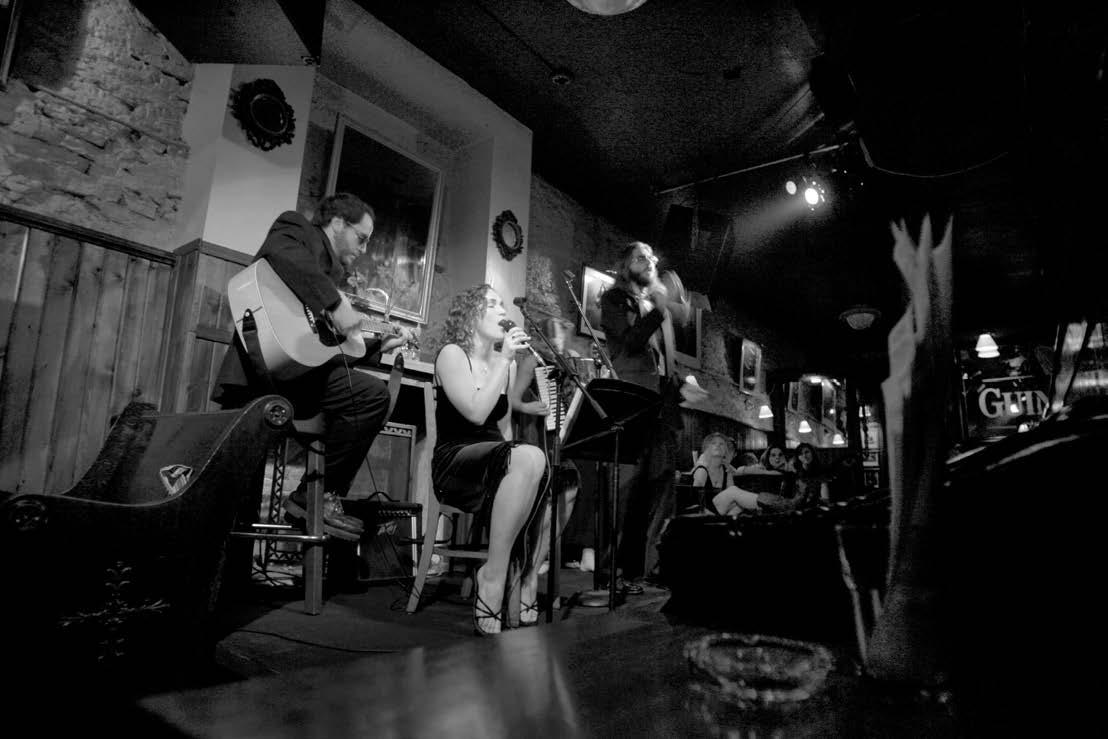
Evan Watson Assistant News Editor news@dailyiowan.com
After over 50 years in business, an Iowa City staple known for its live music and craft beer has closed its doors.
Over the years, a number of bars, restaurants, and social establishments have closed down, erasing small parts of Iowa City. These places, such as The Mill, which closed in 2022, are fondly remembered by current and former Iowa City residents.
Sanctuary Pub, which had been open for business since 1972, closed permanently at the end of December. It is now up for lease, with signs adorning its windows advertising the building’s owner, Barkalow and Associates Realtors. Barkalow and Associates Realtors is helmed by Tracy Barkalow, a longtime Iowa City landlord and property manager.
Barkalow said the Sanctuary Pub space, located at 405 S Gilbert St., is already attracting several potential tenants. Prospects for the space include renewing the Sanctuary Pub name to continue operating it as such or opening a new concept entirely, he said.
Barkalow said Sanctuary Pub went out of business because of a “lack of customer and community support.” The Sanctuary’s owner at the time of closure in December did not provide comment.
The Sanctuary saw numerous changes in ownership over the last decade. The original owners managed it before Daryl Woodson, who came into part-ownership two years later.
In 2017, Dave Stein and Aaron Jennings of Micky’s Irish Pub on Dubuque Street took ownership until 2019. Businesspeople have continued to invest time and money into the space since, but the Sanctuary would only endure another five years.
Iowa City is nothing if not a strong anchor for culture. The University of Iowa creates a unique cycle that, if nothing else, places a time limit on some businesses. One generation of students could patron one establishment, while the next may favor another. New businesses do not always succeed, an idea that shows how special the Sanctuary was to stay for 52 years. For many, especially those long-graduated, the restaurants, bars, and nightlife of Iowa City are the focal point of collective memories. Students from decades ago can recall studying inside the Sanctuary, enjoying a variety of live music and events beneath its dark brown facade.
The Sanctuary was especially commemorated for its over 100 beer offerings, many of them being craft beers that are hard to come by elsewhere in Iowa City or Iowa in general.
For former Iowa City resident and UI student Ryan Kaminky, the beer selection was what set the Sanctuary apart from other bars in Iowa City. Like others, Kaminky said the Sanctuary also had the
distinct ability to set a mood.
“The vibe was excellent,” Kaminky said.
Kaminky worked at the Sanctuary for a brief period during the eight years he was in Iowa City. He said aspects of the Sanctuary were distinctive, such as its “prickly” bar staff.
“They could always offer a suggestion or talk shop, and they were kind in the sense that they were willing to help you out,” he said.
Businesses are always evolving, especially in a place as culturally revolving as Iowa City. The Mill was a community-loved restaurant on Burlington Street. Now, it’s a parking lot. JiangHu Asian Street Food was a spot on Gilbert Street, the walls and windows now occupied by a shop. The Red Avocado is now a mixeduse apartment complex.
These are the places that residents lament no longer exist. Cultural spots with unique offerings and distinct memories that are exchanged for, as Kaminky said, another sports bar that likely cannot endure more than the four years it takes for Iowa City student culture to turn over.
Kaminky is 35 now and resides in Chicago. His time in Iowa City has passed, and he makes a living in a much larger, much busier environment. There is certainly no shortage of culture in one of America’s most populous cities — where else can you go and see a giant bean?
But grandeur is not always most important. The scope of a people, or a place, can also be soundly described by the content within instead of outward appearance. Kaminky made an apt comparison between his faraway perspective of a shifting business environment and the Ship of Theseus — a philosophical thought experiment dating back to ancient Greece. It is a paradox wherein a rotting wooden ship is slowly repaired board by board.
By the end, the ship is the same, but it has been completely refurbished with new boards and structure. The paradox begs the question: Is it still the Ship of Theseus? Or is it something else entirely? Is the Ship of Theseus the boards, the mast, hull, and contents within? Is it instead its purpose for existing, the places it has been to, and the memories individuals have with it?
What is Iowa City? Iowa City is comprised of many factors that distinguish it, and objectively, there is no one thing more attributable to culture than the next.
But wistful are those who see the places that defined their time in Iowa City slowly fade.
The comparison to how people, long gone from Iowa City, slowly lose what ties them to the community reflects the deeper business environment, Kaminky believes.
“It’s so nice going back to a place that
was there when you were young, it makes you feel like you’re still part of the city,” he said. “Every time I go back, something has closed.” There is no shortage of existing business culture in Iowa City, however. Downtown is filled with small businesses that work together to thrive. Rather, a lingering fear is the knowledge that nothing truly lasts forever. A business like the Sanctuary can create a gathering place for people for over 50 years, but eventually even it, too, could not last.
Kaminky said the Sanctuary was a “third place” for him and others. With each board replaced on the ship, the tendency to lose these third places is tested.
Amy Colbert, UI faculty director of social impact community and professor of management and entrepreneurship, defined a third place as a social space outside of home and work where a person can meet new people and create a social life. These spaces include coffee shops, libraries, and parks, to name a few.
Third places are beneficial to the community as a whole, she said, as they help increase the connection between the community and individuals.
“When we feel like we belong, we develop a sense of psychological ownership for our communities,” Colbert said. “People feel like they’re part of the community in a way where they’ll take care of it.” She said a community with too few environments that qualify as third places can see increases in loneliness, stress, and reduced connectedness between people.
“Third places allow us to be human,” she said. “Life unfolds in spaces where we are allowed to be ourselves and where we can see our connections to the rest of humanity. A community without enough third places risks becoming a place where we forget our connectedness and become fearful and self-centered.”
She said Iowa City reinvents itself often due to college turnover, hindering people’s ability to find a third place. Establishments close down, and finding a new place that fits the description and then becoming comfortable there can take time.
Colbert echoed Kaminky’s sentiment that alumni can lose their connection to Iowa City when the places from their memories close down. The Sanctuary is no different and represents a tremendous loss in the eyes of longtime patrons and current residents.
“I watch alumni come back all the time, and they want to go to those places that meant so much to them while they were in college,” she said. “It does feel like a different place when you come back.”
To Kaminky, the Sanctuary was a great tribute to his time in Iowa City; a great variety of craft beer coupled with art and events, all ahead of the backdrop of a unique mood and design.
“It was one of the last remnants of Iowa City,” he said. “Now it’s not there anymore.”

Aaron Hall Holmgren | The Daily Iowan
Hosts of Talk/Art Cabaret at the Sanctuary perform an introductory piece on Sept. 21. The regular event is a place for Writers’ Workshop students to share their work in an unofficial, informal manner.
Matthew Hsieh | The Daily Iowan
John Hass (left) and Jada Jenkins (right) watch election results at Sanctuary Pub in Iowa City on Nov. 3, 2020. Hass and Jenkins were two of four patrons who showed up the entire night.
Lawmakers eye comprehensive review of higher ed
The newly formed Higher Education Committee will review Iowa’s regent universities.
Liam Halawith National Politics Editor liam.halawith@dailyiowan.com
DES MOINES — Iowa Republican lawmakers are eyeing a “comprehensive review” of the state’s higher education system, including the state’s three regent-controlled universities.
A newly formed Iowa House Higher Education Committee, chaired by Iowa Rep. Taylor Collins, R-Mediapolis, was formed at the opening of this session, indicating Iowa lawmakers are taking a heavier hand in governing Iowa’s higher education system, including universities governed by the Iowa Board of Regents.
The new committee comes as Republican controlled states and President Donald Trump’s administration criticize higher education and aim to root out diversity, equity, and inclusion initiatives in academia — action Iowa has already undertaken.
The committee has yet to see regulation referred in the first week of the Iowa legislative session, which gaveled in on Jan. 13. However, the committee has a large scope and is expected to undertake significant reforms this session.
House Speaker Pat Grassley is charging the committee with not only a review of higher education, but also refocusing state universities to address workforce issues in the state.
“A comprehensive review of our entire higher education system is long overdue,” Grassley said in his opening remarks on the first day of the legislative session last week. “Taxpayer investment must be met with taxpayer return. I look forward to this committee’s review of how state dollars can best be used to address workforce shortages and not enforce ideological agendas.”
Collins declined an interview with The Daily Iowan and instead pointed to his opening remarks at the House Higher Education Committee’s first meeting last week.
In his opening remarks, Collins laid out a generalized laundry list of goals the committee will look to accomplish over the next two-year term.
Some of his priorities include increasing intellectual diversity on college campuses, increasing transparency in regent-controlled universities, controlling costs, reforming regent universities’ core curriculum, and reviewing regent universities’ academic programs to align with the state’s workforce needs.
“Last year, this chamber took the first step in reforming our higher education system by getting rid of the identity politics that inserted itself in our higher education system,” Collins said, referring to anti-DEI legislation inserted into the Education Appropriations bill last session that Collins championed. “I want to be clear, the only three-letter acronyms this committee will be focused on over the next general assembly will be MEI. That is merit, excellence, and intelligence.”
Ranking member on the House Higher Education Iowa Rep. Ross Wilburn, D-Ames, said he hopes the committee will focus on creating more opportunity and improving universities, not cutting programs that are not necessarily the top workforce needs in the state but still provide value to the state.
“They talked about a comprehensive review, fair enough, but I still think the focus should be how can we lift up [students], create opportunity, remove any barriers to education,” Wilburn told the DI . “What can we do as legislators to really push high-quality education opportunities to meet the job needs of the state?”
Wilburn also said he hopes Republican lawmakers make the committee’s scope even more clear so Iowans can understand the reforms that might be made and advocate for specific changes.
“I just think it’s important if you’re going to set up a new standing committee that you really give some thought and fulfill the responsibility to explain to the public what it’s going to do,” Wilburn said.
Prior to Collins’ appointment to chair of the newly formed committee, he was
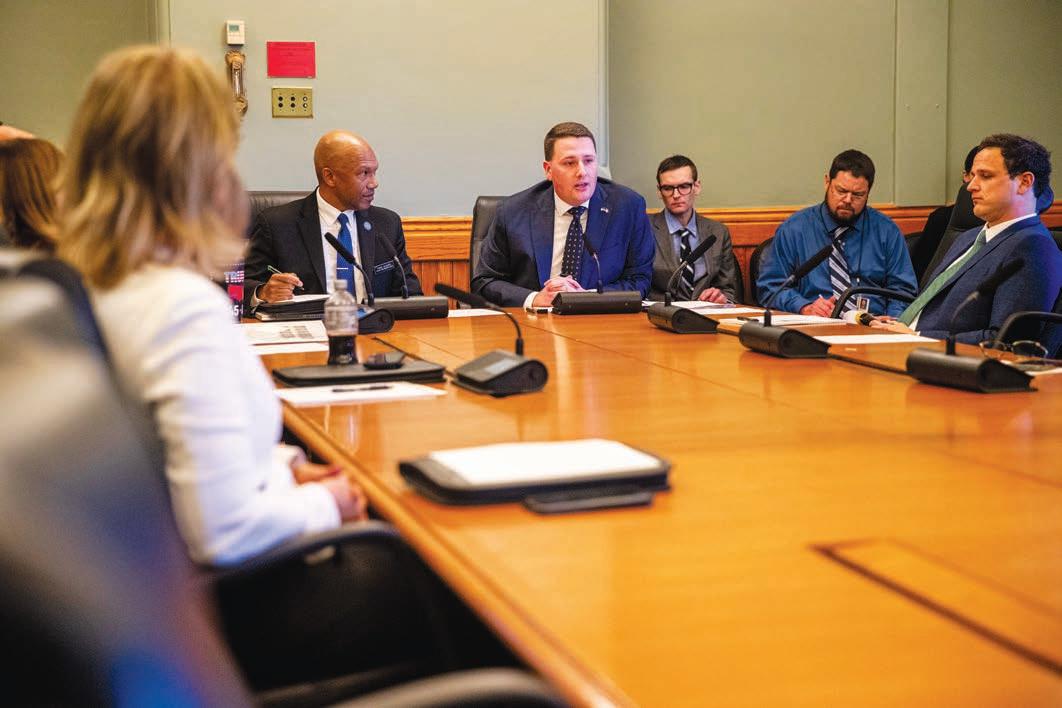
a vocal opponent of DEI initiatives in state universities and has continually criticized Iowa’s regent universities for their compliance to the law and the Iowa Board of Regents’ codified directives.
However, Collins said he does not plan to move forward with additional anti-DEI legislation this session. Instead, he said other legislation including a review of administrative costs, reviewing academic programs, and “protecting taxpayers investments” are key priorities for this session.
While Iowa lawmakers move forward with a comprehensive review of higher education, national headwinds show they are not alone in their heavier hand in state universities.
Higher education reforms reflect national trends
At the federal level, Republicans have attempted to make reforms to the country’s higher education system. House Republicans introduced a bill last year that would have made significant reforms to student loans, pell grants, and financing for universities dependent on federal aid.
Trump and Republicans in the House and Senate have vowed to root out DEI programs in colleges, with Trump’s nominee for Secretary of Education Linda McMahon vowing to work with
ing to do right now.”
According to a study published in the Independent Institute, a right-leaning think tank based in California, bias among academics has shifted to the left in the past few decades with 60 percent of professors identifying as liberal.
Increasing intellectual diversity on campuses
While Collins previously championed laws to eliminate DEI programs from Iowa’s college campuses, he said this session he aims to increase intellectual diversity on college campuses around the state through legislation this session.
Wilburn said Collins’ aim to increase intellectual diversity might be missing the mark because he believes all kinds of diversity are important.
“That’s all part of diversity,” Wilburn said. “He has a misunderstanding of the intent of diversity. We just disagree on that. Certainly, of the importance that diversity offers, whether that’s rural, urban, whether it’s old or younger, whether it’s by gender, whether it’s by race, it’s all important.”
Cary Stough, the president of the Coalition to Organize Graduate Students at the UI, said he credits DEI programs aimed at rural students for his entrance to higher education.
“I want to be clear, the only three-letter acronyms this committee will be focused on over the next general assembly will be MEI. That is merit, excellence, and intelligence.”
Rep. Taylor Collins Chair of Iowa House Higher Education Committee
lawmakers to root out these initiatives.
Republican-controlled states across the U.S. have also looked to root out DEI programs. According to The Chronicle of Higher Education , 14 Republican-led states have signed anti-DEI legislation into law, and 86 bills have been introduced, including in Congress, to eliminate DEI programs.
Adrien Halliez, a political science professor at Drake University, said conservatives have linked higher education institutions among others, to a left-leaning bias, fueling a push for reform.
“I think conservative culture managed to link together, in public opinion, the idea that basically three elements — universities, Hollywood, and the bureaucracy — I think that idea is ingrained that it has a strong left bias,” Halliez said. “That’s why there’s a little bit of traction behind what they’re try -
“I attribute my being able to be in this high academic space from diversity, equity, and inclusion,” Stough said. “I think that’s the only way that the ivory tower has opened up to people like me, and it’s not necessarily, as they would claim, a waste of money, but a proven investment in all students from all different backgrounds.”
While national trends point toward a growing conservative movement wanting reforms for higher education, Iowa has already made reforms with anti-DEI legislation. Iowa Republicans expressed a clear desire for reforms with the creation of a new standing committee focused on higher education.
Collins told Iowa Public Radio in November that members of the House Republican caucus, “are passionate about reforming our system and making sure that we’re not wasting taxpayer money on initiatives or agendas that do not benefit Iowans.”

Committee aims to review degree programs
Collins said another priority for the committee will be reviewing academic programs offered by universities to ensure they align with the state’s workforce needs. He also said he is looking to reform the regent universities’ core curriculum.
His desire to review the academic programs offered by regent-controlled universities, like the UI, comes as he criticizes the university’s development of a new school of School of Social and Cultural Analysis.
The new school combines the Gender, Women’s, and Sexuality Studies program with other cultural analysis departments at the UI.
“Iowans expect our institutions of higher education to be focused on providing for the workforce needs of the state, not programs that are focused on peddling ideological agendas,” Collins wrote in a letter to the UI, co-written by Iowa Sen. Lynn Evans, R-Aurelia, who
chairs the Senate Education Committee. Wilburn said he hopes Collins will bring educators to the table when looking to reform academic programs and curricula, but he thinks there is certainly room for improvement in a broad sense.
“It’s important to allow some flexibility for the jobs of the future and professions of the future that we don’t know exist yet, and we don’t want to have Iowa behind the curve of other states that allow that academic freedom to happen,” Wilburn said.
Chris Martin, the union representative for the University of Northern Iowa’s faculty union, said looking into what degree programs the universities are offering will end up hurting workforce readiness. Martin said it will put the state behind workforce needs by years if they’re waiting to see needs before creating a program.
“I think it’s a little bit of micromanaging happening there,” Martin said. “I think it’s the job of the university administrations and faculty to look at what programs are working and not working.”
The letter is not the first criticism Collins has levied against state universities attempting to comply with the anti-DEI legislation he championed last session, which goes into effect in July.
While Collins has said no new DEI legislation is expected this session, he is likely to take a leading role in ensuring compliance with the law meets the guidelines set out in law. Instead, Collins said the committee will focus on other reforms to the state’s higher education system.
Higher education facing ‘a crisis of confidence’
Collins, in his opening remarks to the House Higher Education Committee, said the committee was necessitated by a need to restore Iowans’ confidence in higher education.
The House has only had a higher education committee once before, which was formed in 1971 after U.S. involvement in the Vietnam War led to anti-war protests disrupting college campuses across the nation.
“I think it’s important to note that the last time there was a higher education [committee] was over 50 years ago, in 1971 — a time when our campuses were in chaos, and it had reached the level of crisis,” Collins said last week. “Today, our higher education system faces a similar crisis, that is, a crisis of confidence.”
Collins said there is a need to refocus universities from “ideological agendas and back to the pursuit of academic excellence.”
However, Martin said universities never left the pursuit of academic excellence, and lawmakers’ plans sound instead like replacing one ideology with another.
“The legislature certainly has the right and expectations from citizens to do a review of any kind of state-funded program,” Martin said. “So, I think that’s fine, but they shouldn’t approach that with any kind of predetermined conclusions.”
Stough said graduate students are given the freedom to study any side of the ideological spectrum they choose, and Collins’ rhetoric is limiting academic freedom by insinuating that the inverse is happening in state universities.
“Being labeled as a proponent of just one ideology is confusing and doesn’t necessarily mirror our reality at all,” Stough said. “It is disappointing, and it does add pressure on us as researchers and as educators to where, even though we do feel supported in our academic freedom, rhetoric such as Collins’ and others in the state makes us question the limits of what we’ve been given.”
| The Daily Iowan
Chair of the Iowa Higher Education Committee Rep. Taylor R. Collins speaks during the second day of the 2025 Iowa legislative session at the Iowa State Capitol in Des Moines on Jan. 14. Collins has been serving as an Iowa state representative since 2023.
Cody Blissett | The Daily Iowan The Iowa State Capitol is seen following the Condition of the State address in Des Moines on Jan. 14. Education, immigration, and childcare were listed as high priorities for the 2025 session.
Candidates campaign for city council
Three candidates will seek Iowa City’s vote in a primary election on Feb. 4.
Madison Schuler News Reporter news@dailyiowan.com
Three candidates have risen to fill Andrew Dunn’s recently vacated Iowa City City Council seat, and each are campaigning to win Iowa City’s vote. In just a few short weeks, Iowa City residents in District C will be able to cast their votes in a primary election.
Sharon DeGraw, Ross Nusser, and Oliver Weilein are all campaigning and gathering support in hopes of being elected.
During the primary election, only residents of District C, which encompasses much of the northside neighborhood and reaches just past Interstate 80, will be eligible to vote. A second special election, which is any election that is not regularly scheduled, will be held a month later on March 4, where all Iowa City residents can vote.
After Dunn announced his resignation in October, the city council approved hosting the special election in December to fill the vacancy. According to Iowa law, a vacancy among a council must be filled either by appointment or special election. Since there are three candidates currently running, a primary election will also be held on Feb. 4. According to council documents, the primary election along with the special election will cost $100,000 to organize.
Once elected, the chosen candidate will continue for the rest of former Councilor Dunn’s term, which ends on Jan. 3, 2028.
Josh Moe, a current councilor on the city council, shared concerns about a low-voter turnout for the election.
“We know that people have voter fatigue, or get voter fatigue, and we know that in
off-cycle elections, people might not be paying attention, and that can be a challenge,” Moe said.
Nonetheless, Moe said he is looking forward to the election and is committed to working with the new council member.
“I’m committed to being a good coworker and colleague with whoever is elected, and I think that for the most part, our current city council is really respectful to each other, but disagrees. And I think we model democracy and sort of civic debate really well,” Moe said. “I hope that the person that gets selected continues to sort of follow through with that ethic.”
DeGraw, who is one of the three candidates, has experienced Iowa City as a student, professor, and resident. As a student at the University of Iowa, DeGraw earned an MFA in Book Arts from the Center for the Book, where she later taught.
In addition, DeGraw has also been an active part of the community as she serves on the Iowa City Historic Preservation Commission and was elected as co-chair of the Northside Neighborhood Steering Committee.
She said attending Iowa City City Council, Planning and Zoning Commission meetings, and speaking on behalf of Northside residents inspired her to run.
“I like to follow what’s going on in scientific invention, engineering, and where the future is going,” DeGraw said. “I get excited about that and want to see Iowa City blossom in an economy more so than it is already.”
DeGraw also spoke about her main priorities, which include advocating for affordable housing, women and vulnerable communities, and a vibrant, inclusive
city that attracts both businesses and residents. She also wants to balance development with sustainability.
“I would be receptive to working with organizations should legislation come that can have adverse effects on vulnerable people,” DeGraw said.
Nusser, a real estate agent local to Iowa City, said he was prompted to enter the race due to his longtime ties in the community.
“I care so much about this community, and having the ability to serve the community helps me feel more connected within,” Nusser said.
Nusser expressed his passion for public service and involvement with nonprofits. He holds a position on the Housing Fellowship Board of Directors, which supports people’s search for housing, and serves as the board president for Community and Family Resources.
Community and Family Resources provides advocacy, prevention, and treatment of substance abuse, gambling addictions, and other mental health issues.
In addition, Nusser works with Successful Living, a nonprofit that helps adults with chronic mental illnesses.
If elected, Nusser said his top priority includes affordable housing, especially since the city’s upcoming process is to update the comprehensive plan.
“I envision the future of Iowa City as being strong regardless of whether or not I’m elected to city council,” Nusser said. “I envision playing a role in helping support Iowa City, helping support the organizations that help make Iowa City a wonderful place to live and thrive.”
The last candidate, Oliver Weilein, has
been an active part of Iowa City for the past 10 years.
Weilein works with the Center for Worker Justice, the Iowa City Tenants Union, Public Space One, the Emma Goldman Clinic. Weilein also raises funds for the Shelter House, and volunteers at the Iowa Farm Sanctuary. He focuses on housing justice, immigrant justice, advocating for tenants dealing with abusive landlords, and helping families fight eviction.
“I think that the mood and the attitude is to really tackle housing and homelessness in a very transformational way — it’s the main reason why I decided to run because the current makeup of [the] council and the atmosphere in the city and county in general is people want to solve that issue,” Weilein said.
Weilein said he has continued to gain support and spread his message by door-knocking and reaching out to various communities, such as immigrant and LGBTQ+ communities.
If elected, Weilein will propose higher fees on vacancies, community land trusts, and right of first refusal laws to address housing affordability issues. He also stresses the importance of direct communication with unhoused individuals to advocate for their needs in city council.
“I think a candidacy like mine would strengthen and embolden working-class people, whether it be tenants, whether it be union and nonunion workers alike, to organize themselves and really advocate for themselves,” Weilein said.
All three candidates will continue to campaign up until the primary election on Feb. 4. The two candidates with the most votes will advance to the special election.
Mandi Remington begins term as JoCo supervisor
Remington says she wants to pursue housing and climate action during her term.
After years of developing her presence in the Iowa City community, Mandi Remington has started her term as the newest Johnson County Board of supervisor. She enters as the board begins developing its 2025 budget with priorities to support housing and climate initiatives.
Remington successfully unseated incumbent Royceann Porter in the Nov. 5, 2024, general election and campaigned with the promise of addressing county issues such as access to essential services like housing and child care and income barriers such as transportation and language.
With her official term having begun on Jan. 2, Remington is only a few short weeks into her time as a Johnson County supervisor.
“I’m absolutely loving it,” she said. “I’m getting to spend time on my workday learning more about the county’s challenges and opportunities and meeting folks who make everything happen. I’m having a lot of important conversations.”
While this is Remington’s first time doing paid community work at this level, she sees it as the logical next step in a history of community assistance.
Remington has chaired the Iowa City Community Police Review Board, the University of Iowa Safety and Security Committee, and the UI Council on the Status of Women.
Remington also founded Corridor Community Action Network, or CCAN, a nonprofit organization dedicated to improving the quality of life for residents in the Iowa Corridor, particularly focusing on addressing critical social issues and creating opportunities for under -
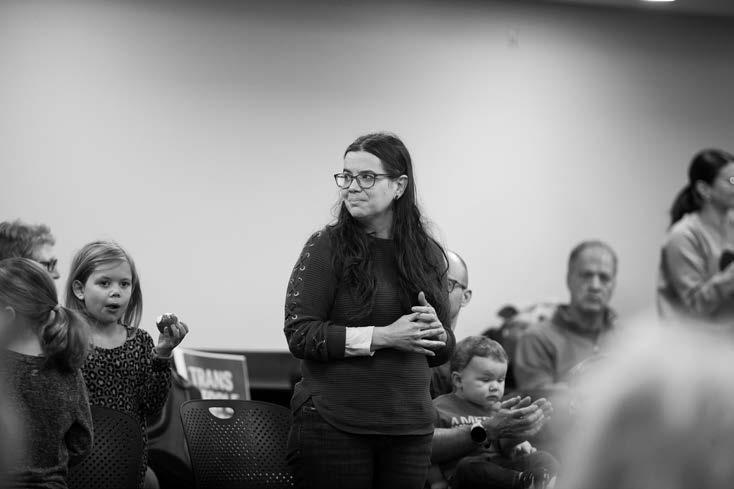
served and vulnerable populations.
“Over the last five years, I’ve done a lot of work addressing community needs as the volunteer founder and director of Corridor Community Action Network,” she said.
Remington hopes to use her new role on the board of supervisors to improve community engagement with local government.
“One thing that came up over and over again during the campaign is that so many people don’t know what the Johnson County supervisors do, or people didn’t know that there was a primary
Crumbl Cookies coming to Coralville
The franchise is planning to open their new location later this spring.
chise’s ninth location in the state.
With Crumbl’s proximity to Iowa City and the University of Iowa, its awaited opening has drawn mixed reactions from UI students.
election happening,” she said.
Remington cited the Feb. 4 primary election for the Iowa City City Council as an example of residents’ unawareness of their opportunities to participate in local government.
“A lot of people want to get involved in these things, and they just don’t really know how, and I think that there is a lot of room in place for the government to step in and improve that,” she said.
Jon Green, now the chair of the Board of Supervisors, voiced his excitement for Remington’s appointment.
“I supported her candidacy,” he said.
“I’m excited about the work and all that we are going to accomplish in the next few years.” Green said Remington’s first few weeks have gone smoothly. He particularly thought her appointment was less chaotic than his, which saw him run in a special election in 2021 and did not leave as much time for training in his position.
“It is fortunate that with [Remington] coming in after a general election, that she gets to avail herself of that training pretty much immediately,” he said.
While Green agrees with Remington’s stances on increased access to housing and climate action, he foresees the Iowa legislature, which recently started its 2025 session, to be a possible obstacle to their ambitions.
“All of the smoke signals coming through the legislature indicate that they want to further restrict local municipalities, both cities and counties, in terms of what we have jurisdiction of,” he said. Green specifically alluded to House File 295, a law passed by the Iowa House of Representatives in 2017. The law restricts local governments from enacting ordinances that exceed or conflict with state or federal laws, effectively nullifying local minimum wage increases.
Supervisor Rod Sullivan also voiced his approval of Remington’s appointment. Sullivan sees the board’s February county budget votes as Remington’s first significant task as a supervisor but acknowledged her ability to grow quickly.
“I don’t think anybody feels like they have a really good handle on this stuff until they’ve served the whole time,” he said. “But I think that Mandy has demonstrated already that she’s a quick learner and a very hard worker, and those are two really good qualities to bring to the board.”
Coralville residents have started to notice new signs, directing their eyes to a currently vacant building. The signature simple pink logo with black bubble letters advertises the opening of Crumbl Cookies, a bakery franchise launched in 2017 that is now a national chain. Besides its address at 2799 Commerce Dr., little is known about Coralville’s soon-to-be first Crumbl location.
In an email to The Daily Iowan, Crumbl’s media relations team wrote, “We cannot confirm an exact opening date or additional details for Crumbl-Coralville at this time, although we are working on it and hoping to see that particular store open in early to late spring.” Crumbl clarified further, writing that the media relations team only receives in-depth details about a location a few weeks prior to its opening.
The franchise began in 2017 when cousins Sawyer Hemsley and Jason McGowan founded the chain in Logan, Utah. Since 2023, the franchise has spread to every state across the country with eight locations in Iowa. The Coralville location will mark the fran -
Hannah Maschino, a second-year student at Iowa, was excited to hear the news of Crumbl opening in the neighbor ing city of Coralville.
“I think it’s really cool that they’re bringing it to Coralville,” she said. “A lot of other towns have it, like college towns. I’m always seeing things on social media about it. I’m from a small town, so I don’t usually get to try all these chains.”

Maschino also said she does not believe the bakery’s location in Coralville is too far out of reach for students to enjoy the store’s cookies.
“I kind of view Iowa City and Coralville as the same because they’re pretty much together,” she said. “I think it would be close enough. I have my car so I can drive there. I know some other college students in Iowa City probably don’t have a car, so maybe not for them, but I still think that they would have pretty good business there.”
Some students, like first-year Penelope Alvis, are not as optimistic about the opening. Alvis said she thinks it does not add much to the options
already available nearby.
“I think it’ll be really popular because people love Crumbl,” she said. “But we already have Cookies and Dreams in Coralville, and it’s an amazing cookie shop. I think it might take away business from that, and it’s also way better than Crumbl and makes Crumbl-sized cookies.”
Alvis believes the new bakery will enjoy good business, but the bakery franchise can’t compare to Cookies and Dreams, which is located three miles from the Crumbl location. She also said
she felt Crumbl’s entire cookie selection blended together in sweet-spiked monotony. “They’ll just change one thing and pretend that it’s a completely different kind of cookie,” she said.
Despite her preferences, Alvis said Crumbl expansion into Iowa City could benefit the franchise, and she’d like to see it come to Iowa City.
“I think it would be possibly more successful if it opened in Iowa City versus in Coralville, just because there are more people in Iowa City,” she said.
Isabella Tisdale | The Daily Iowan Crumbl Cookie’s new location is seen in Coralville on Jan. 20. Crumbl originally started in Logan, Utah eight years ago.
Isabella Tisdale | The Daily Iowan Johnson County Supervisor Mandi Remington speaks to a crowd during a singing circle and People’s March at the Coralville Public Library on Jan. 18. The event was part of a string of nationwide People’s Marches in response to an upcoming Trump administration.
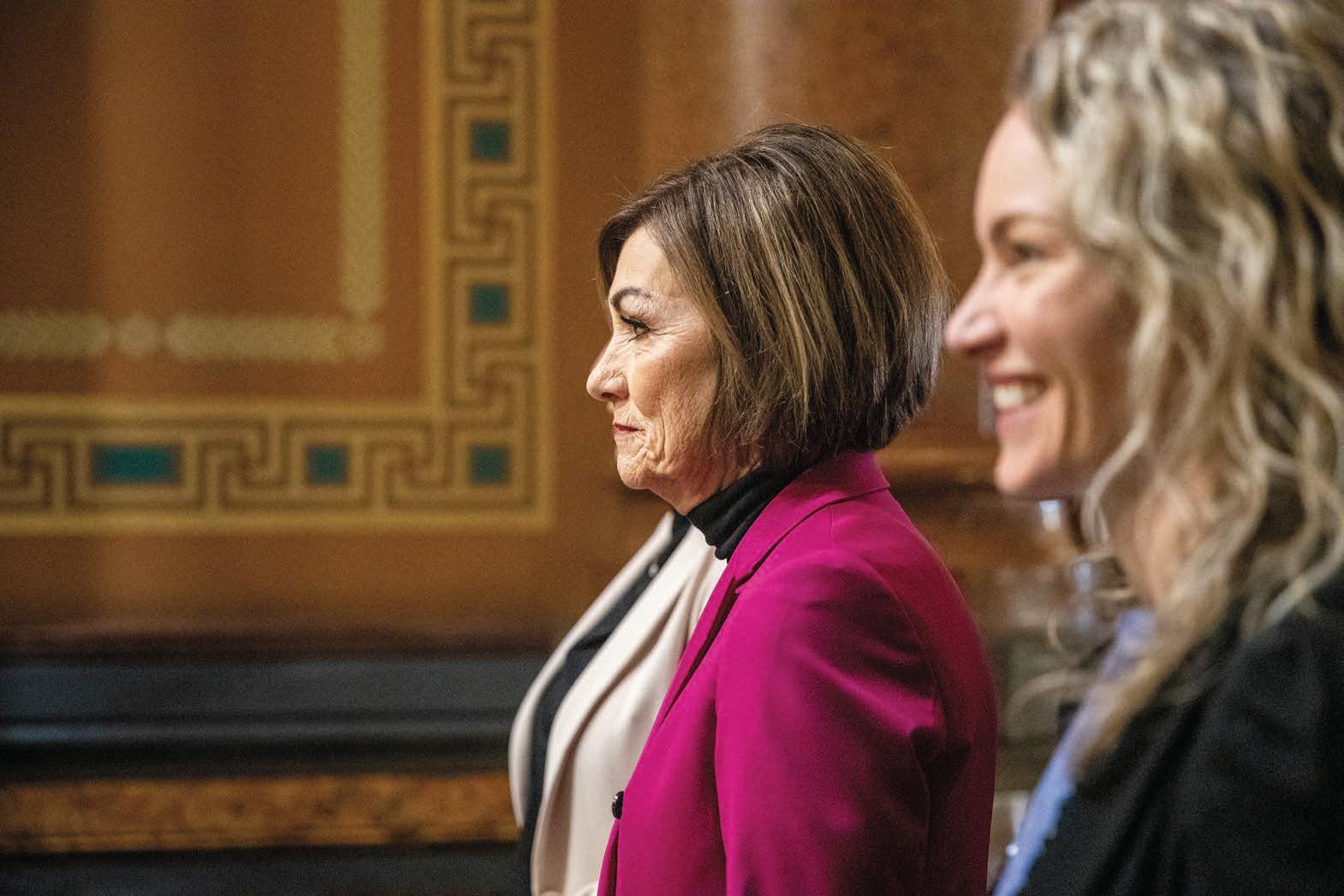
Iowa’s 2025 legislative session
Education, immigration safety, and child care were listed as high priorities for Iowa’s docket in 2025. The session is currently slated to conclude in early May.
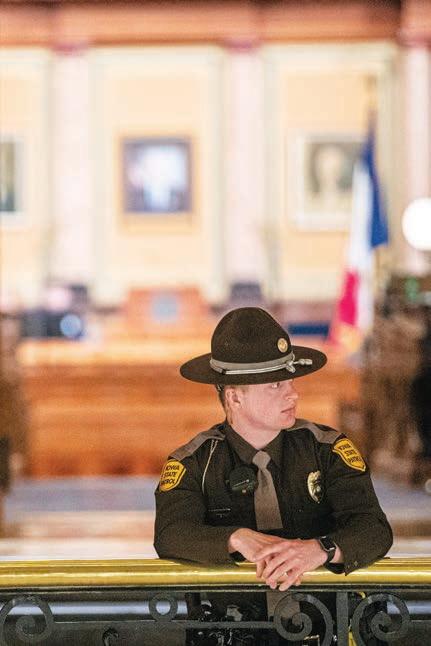
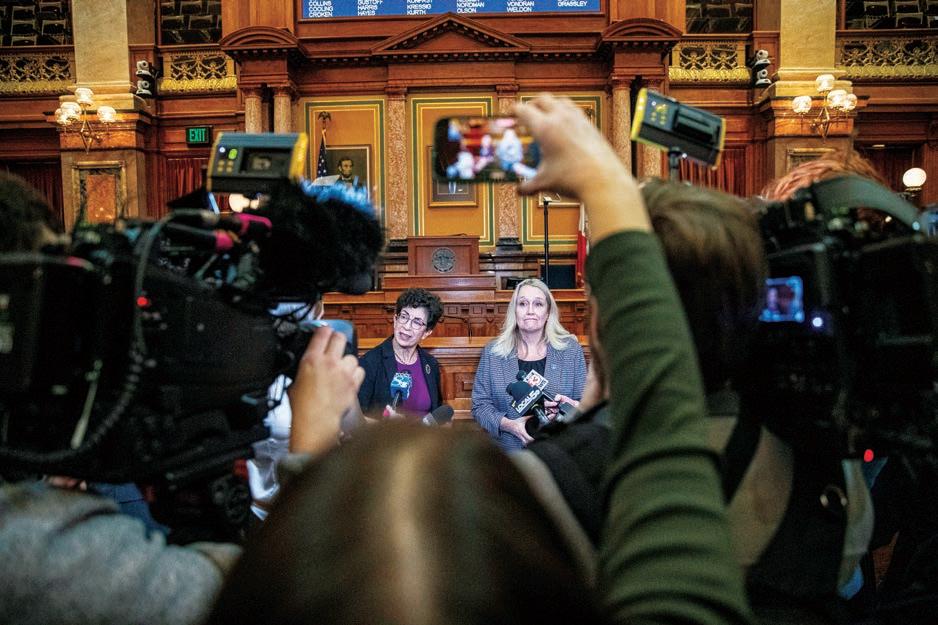
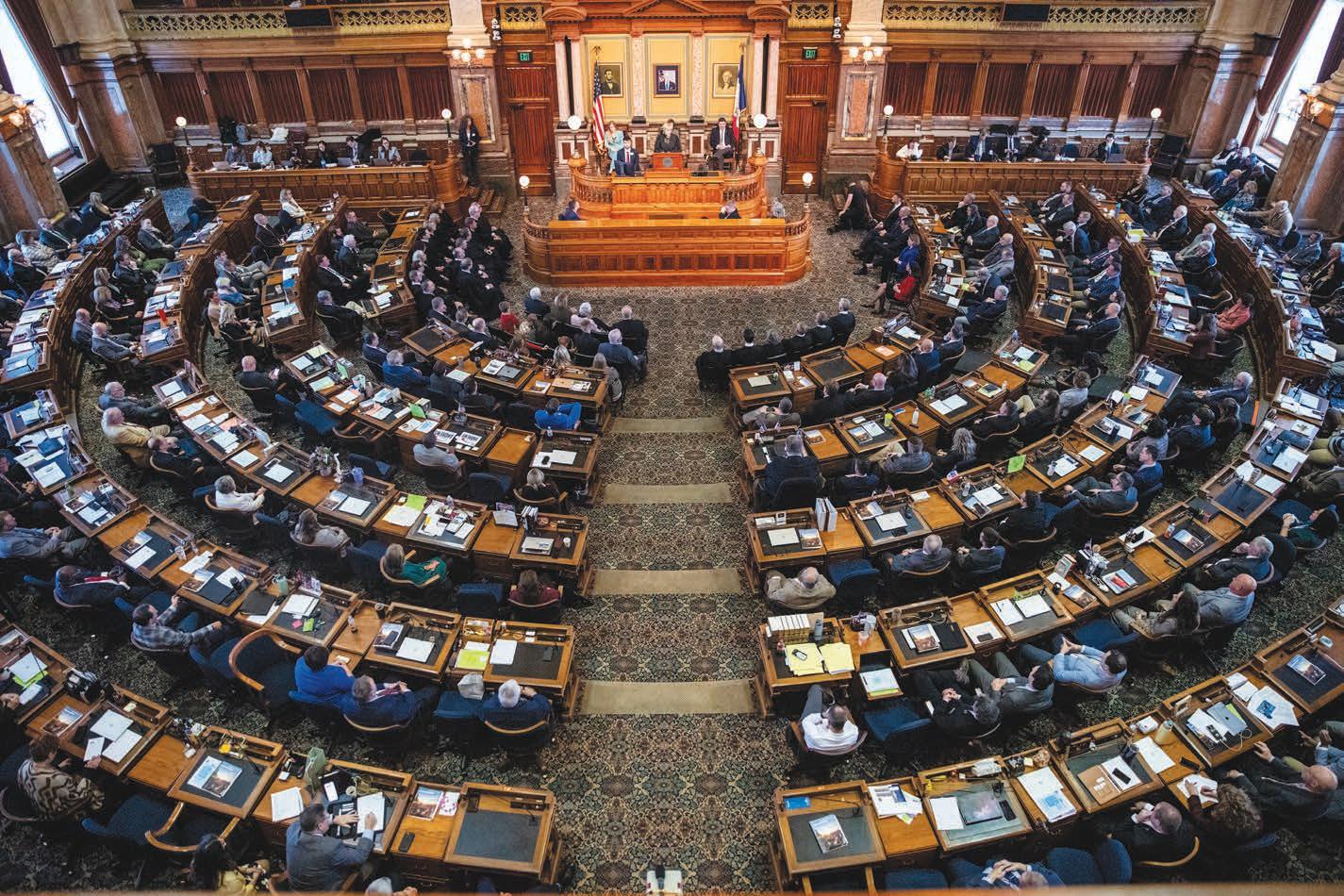
Cody Blissett | The Daily Iowan
(Top) Iowa Gov. Kim Reynolds prepares

ATHLETICS
The minds behind Iowa athletics’ hype videos
Iowa staff works behind the scenes to make each team stand out on the screen.

Iowa Assistant Athletics Director for Creative Content Caleb Saunders takes a video of an
Jack Birmingham Sports Reporter sports@dailyiowan.com
The crowd is on its feet at Carver-Hawkeye Arena. Thousands of fans are packed into a stadium that sold out with women’s basketball tickets for the second season in a row. The music blares as clips of Iowa’s Final Four runs are showcased to a sea of black and gold. The acoustics reach 106.5 decibels — nearly the sound of a jet engine.
MEN’S WRESTLING
Flames shoot into the air. Highlights fill the video screens. The fans roar their approval as a result. With the roaring success of the women’s basketball program over the last few years, Carver-Hawkeye Arena is a nightmare for visiting programs.
Sports, especially at the Big Ten level, have garnered a huge fan base at countless schools, and Iowa is no exception with 22 varsity teams to the university’s name.
When Iowa’s athletics programs square off in front of an energized crowd, these
highlights — including a clip of Nile Kinnick’s famous Heisman Trophy speech before football games or Herky’s arrival at basketball games — add to the environment.
Iowa staff members work behind the scenes to make each team stand out in a blaze of glory, and the athletic department’s creative content unit is spearheading the effort.
The media personnel involved with these teams oversee the creation of much of the content that plays at Carver and
Iowa men’s wrestling hopes shuffled lineups lead to success
Five different wrestlers have been switched in-andout of the 125- and 141-pound weight classes.

consistent front half of the lineup. It is no secret Brands has been unpredictable this season regarding lineups, as he has made lineup decisions on what he feels is the best for the squad.

Kinnick Stadium. Caleb Saunders, Iowa’s assistant athletic director for creative content, credits the success of both the teams and the media to the camaraderie between both parties.
“I think we have created a relationship with our teams,” Saunders said. “We really enjoy getting to work with our coaches and ath-
WOMEN’S BASKETBALL
Five-game skid, zero concerns
Jan Jensen and the Iowa women’s basketball team remain confident amid mid-season struggles.
Chris Meglio Pregame Reporter sports@dailyiowan.com
The Iowa women’s basketball team has been spoiled with great success over the past three seasons, earning three Big Ten tournament titles and qualifying for consecutive NCAA national championship games in 2022 and 2023.
But the first season of the post-Caitlin Clark and Lisa Bluder era has presented some struggles. The Hawkeyes went through a dismal 4-5 stretch after beginning the year with an 8-0 start. Questions are warranted, and the team is searching for answers.

“I don’t think we’ve totally figured it out yet,” fourth-year guard Lucy Olsen said. “We know that this adversity is just going to get stronger in the future. We’ve done a lot of talking and some team bonding that I hope will fix it all.”
Iowa’s five-game losing skid came at the hands of five conference foes in then-No. 8 Maryland, Illinois, Indiana, Nebraska, and Oregon and it has been held to less than 70 points in four out of the five losses.
It has now been four years since the Iowa men’s wrestling squad defeated powerhouse Penn State to win its 24th national championship in program history. Since that glorious day in 2021, Iowa has yet to return a national championship banner back to “Wrestle Town USA,” leaving Hawkeye fans across the country eager and hungry for another title. Iowa and Penn State have held the No. 1 and No. 2 spots in the National Wrestling Coaches Association rankings since the initial preseason rankings back in October, and wrestling fans are already counting down the days to their highly anticipated showdown on Jan. 31 in State College, Pennsylvania. Iowa head coach Tom Brands has used the early portion of the season to weigh his options in the front half of the lineup.

Despite the questionable front half of the lineup, one thing remains clear: Iowa will struggle to defeat fellow Big Ten foe Penn State for a national title without a
In all, there have been five different wrestlers who have seen action between the 125 and 141 weight classes, creating an anxious atmosphere for Hawkeye fans who are eager to see who will step on the mat.
One of those notable decisions came against in-state rival Iowa State on Nov. 23 when Brands elected to give first-year Angelo Ferrari the big stage at 184 pounds. Brands’ choice ultimately proved to be successful, as Ferrari defeated No. 15 Evan Bockman, 8-2.
When asked why he decided to start Ferrari on the mat, Brands offered a straightforward answer that required no follow-up questions.
“Just shaking it up,” Brands said before the dual.
The Hawkeyes’ lineup changes in the top half of the order have also been finding a groove, especially in the 125 and 141 weight classes. Brands has fluctuated between Iowa native Kale Peterson and Oklahoma transfer Joey Cruz at 125.
Two of those games, Jan. 5 against Maryland and Jan. 12 against Indiana, saw the Hawkeyes fall to a deficit and play catch-up the rest of the way. It’s been a common theme all season, though the difference is they were able to take the victory against those non-conference opponents.

“I would say just for us, not really dwelling on the past,” first-year guard Aaliyah Guyton said. “I think just focusing on being as consistent as we can starting off with the first few minutes in the game is very important. And just sticking together, because being separate won’t make it any better.” The road game against Illinois on Jan. 9, however, was the opposite of the other two. The Hawkeyes held a lead early for a brief period before the Illini fought back, and the two teams tussled with it before Illinois pulled away toward the middle of the fourth quarter. Iowa head coach Jan Jensen admitted to her frustrations after the Illinois loss but thought the team
Isabella
Isabella Tisdale | The Daily Iowan
Iowa 133-pound Kale Peterson celebrates after defeating American University Max Lee during session two of Soldier Salute at Xtream Arena in Coralville on Dec. 29, 2024.
HYPE | 3B
Guyton
Men’s Basketball
Friday, Jan. 24
Penn State Iowa City, Iowa
8 p.m.
Women’s Basketball
Wednesday, Jan. 22
Washington Seattle, Washington
8 p.m.
Men’s Wrestling
Saturday, Jan. 25
Ohio State Iowa City, Iowa
1 p.m.
Women’s Wrestling
Saturday, Jan. 25
Lock Haven Albany, New York
11:15 a.m.
Tennis Friday, Jan. 24
Kentucky Iowa City, Iowa
12 p.m.
Track and Field
Friday and Saturday, Jan. 24-25
Larry Wieczorek Invitational Iowa City, Iowa
WHAT YOU’VE MISSED
Iowa football’s quarterback room became a lot more competitive in January, as South Dakota State quarterback Mark Gronowski will transfer to the Hawkeyes.
A three-star transfer from 247 Sports, Gronowski becomes the second quarterback transfer for Iowa, joining Auburn’s Hank Brown, but has the edge in starting experience. He boasts a 49-5 career record and back-to-back national titles. A dual-threat under center, Gronowski boasts 10,330 passing yards, 93 touchdowns, and 20 interceptions to go along with 1,767 rushing yards and another 37 scores. He has one year of eligibility remaining. Starting 10 games as a true freshman in 2020, Gronowski threw for 1,584 yards and 15 touchdowns before suffering an injury in the FCS championship game that season. After missing the following year to recover and burning a redshirt in the process, Gronowski improved his completion percentage by nearly nine points and tacked on 11 more passing touchdowns. He led the Jackrabbits to a 14-1 record culminating in a victory over rival North Dakota State in the FCS title game, where he took home MVP honors.
The following season, Gronowksi had himself a 3,000-yard passing season, leading the FCS in passing efficiency with a 179.7 rating. The 6-foot-3, 230-pounder earned the Walter Payton Award as the FCS’ best offensive player and a first-team FCS All-American nod from the Associated Press. The Jackrabbits went undefeated and won their second straight title.
In his most recent season, Gronowski posted 2,721 passing yards and a 60.9 completion percentage, tossing 23 touchdowns and seven interceptions. He added 380 yards on the ground and 10 rushing touchdowns.
Gronowski joins Brown as well as third-year Brendan Sullivan, who started two games for the Hawkeyes last season but was limited due to an ankle injury that kept him out of two contests. The trio will be joined by incoming recruits Jimmy Sullivan and Ryan Fitzgerald. Including walk-on transfer Jackson Stratton, who started the two games in Sullivan’s stead, the Hawkeyes have six quarterbacks on the roster.
Kirk Ferentz needs to fix Iowa football in 2025
Hayden Fry retired after a losing record in 1998, and Ferentz could face a similar fate if he can’t turn things around next season.
Brad Schultz Assistant Sports Editor brad.schultz@dailyiowan.com
Kirk Ferentz and Hayden Fry have plenty of great things in common.
Both men have led the Iowa football program for lengthy periods and have been very successful in the process, with Fry winning a then-school record 143 games during his 20-year tenure. Ferentz succeeded him in 1999 and has collected 204 victories and counting over his 26-season career with the Hawkeyes.
Fry’s accomplishments with Iowa earned him a spot in the College Football Hall of Fame in 2003, an honor that Ferentz is on track to receive if he reaches a career-winning percentage of .600.
Both of these coaches will undoubtedly remain Hawkeye legends until the end of time, but there is one unfortunate correlation that stands out between both Fry and Ferentz: They may have stayed in their position for too long.
Let’s explain.
Before Fry took over in 1979, Iowa was regarded as one of the worst programs in college football and hadn’t even recorded a winning season since 1961. Despite the massive obstacle in front of him, it only took three seasons for Fry to win the Big Ten and reach the Rose Bowl.
Fry’s success continued throughout the 1980s and into the early 1990s, which included two additional conference crowns and nearly a national championship during the 1985 season.
After an incredible 10-1-1 season in 1991, things began to go sour for Fry and the Hawkeyes. Iowa missed a bowl game in two of the next three seasons, and it became clear the Hawkeyes’ glory days under Fry were already well in the past.
The Hawks responded with respectable seasons of 8-4 and 9-3 in 1995 and 1996, but a mediocre 7-5 campaign in 1997 signaled Fry’s legendary reign as head coach was coming to an end. Sure enough, Fry retired after a dismal 3-8 season in 1998, his worst season in Iowa City.
While many fans were sad to see Fry leave, the general consensus amongst the fanbase and even Fry himself was the 69-year-old coach had stayed just a little too long. Health issues began to take their toll on Fry in his last years, including a bout with prostate cancer during his final season that likely affected his ability to recruit and fully manage day-to-day team responsibilities.
These final down years left Ferentz entering a difficult position, but he also didn’t take long to bring the program back to national prominence, winning Big Ten titles in 2002 and 2004, including a berth in the 2003 Orange Bowl.
Iowa entered a down period after 2004,
Q&A | KYLIE WELKER
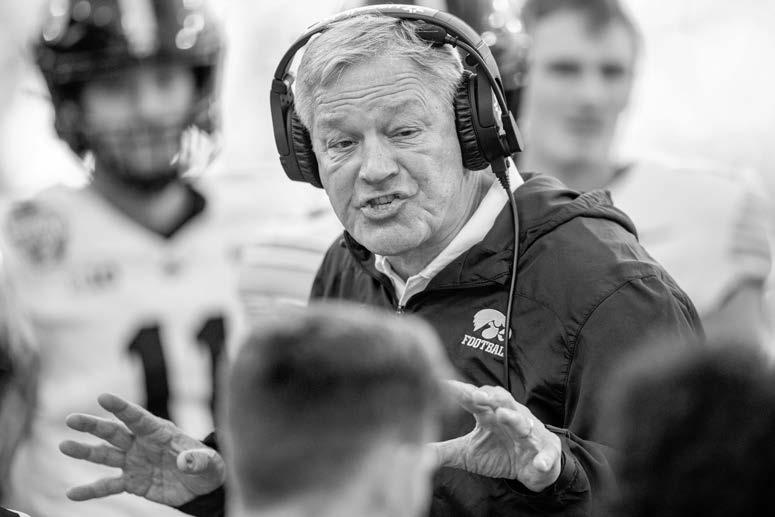
forcing many fans to call for Ferentz’s job, but responded with an 11-2 campaign during the 2009 season. The Hawkeyes narrowly missed out on another conference title but claimed a historic victory in the 2010 Orange Bowl, the school’s first and only major bowl game triumph since the 1959 Rose Bowl.
Iowa has remained a consistent winner under Ferentz since then but hasn’t really come close to those glorious 2009 heights, with the lone exception being the historic 12-2 campaign in 2015. Sure, the Hawks have won a couple of Big Ten West titles in recent years, but they did not put up anything resembling a fight in those games, failing to score a touchdown in each contest.
Winning 10 games every few seasons is a nice accomplishment, but the consistent discourse from the national media surrounding Iowa’s putrid offense has washed away any fond memories from those campaigns.
Those problems fall on Ferentz.
The Hawkeyes have never featured explosive offenses in the Ferentz era, and that’s not something that’s going to change for the rest of his career. But when you consider that some of those horrible offenses have ruined elite, championship-caliber defenses, then that’s a huge problem.
New offensive coordinator Tim Lester showed some improvement in 2024, but that doesn’t hide the fact that 2024 was one of the most disappointing seasons under Ferentz.
Iowa women’s wrestler talks music, TV shows
Jackson Miller Sports Reporter sports@dailyiowan.com
The Daily Iowan: What do you enjoy most about being a part of this team?
Kylie Welker: For me, it’s more like a family. It’s not as much of a team. These girls are always high-energy, and they always have my back, so being able to be a part of something so special is my favorite thing.
What is the toughest conditioning workout you’ve had to do at Iowa?
Probably the Carver stairs. Those are always really hard.

8-4
With the college football season officially over for the Iowa football program, it’s now time to do what most sane people do in the offseason — create a way-tooearly prediction for the Hawkeyes’ upcoming year.
QUOTE OF THE WEEK
“We’re going to be on top of that podium, so that’s the end goal.”
Iowa men’s wrestler Gabe Arnold after a 45-0 team win at Wisconsin on Jan. 12
STAT OF THE WEEK
Quarterbacks on Iowa football’s roster for 2025
To perfectly analyze a prediction for next season, we must ask ourselves one question: Who are the key departures and returners on this Iowa roster?
First, let’s look at the offense.
Highlighting the roster for 2025 is quarterback transfer Mark Gronowski from South Dakota State. The Jackrabbit play-caller led the program to its first two subdivision championships while accumulating 10,300 total yards and almost 100 all-purpose touchdowns.
While no single player will be able to replace Kaleb Johnson anytime soon, the Hawkeyes are returning the running back duo of Kamari Moulton and Jaziun
What is your favorite movie or show?
My all-time favorite show is “Vampire Diaries.” I’ve watched it three or four times.
Who inspires you the most, and why?
Iowa returned plenty of starters on both sides of the ball and faced a favorable schedule, leading some national analysts to project the Hawkeyes as a potential dark-horse candidate to make a run to the College Football Playoff.
Instead, Iowa slumped to a frustrating 8-5 finish that included losses to 5-7 Michigan State and UCLA teams. The Hawks continued an embarrassing nine-game losing streak against ranked opponents and suffered a second consecutive home loss to in-state rival Iowa State.
These failures have left many longtime Iowa fans anxious about the future of the program, and the calls for athletic director Beth Goetz to move on from Ferentz have increased in the weeks following the end of the season.
I don’t envision Iowa slipping down to a losing record like it did with Fry in 1998, but Ferentz’s inability to compete in big games and field even an average offense over the last few seasons has left a bit of a sour mark on an otherwise fantastic career.
It’s hard to forecast what could happen in 2025, but the Hawkeyes could be in for a difficult campaign considering their recent history with inconsistent quarterback play and a challenging schedule.
If things cannot get turned around in 2025, then it might be best for Ferentz to step away on his own terms, a right he has earned and deserves, before he follows in the unfortunate footsteps of his predecessor.
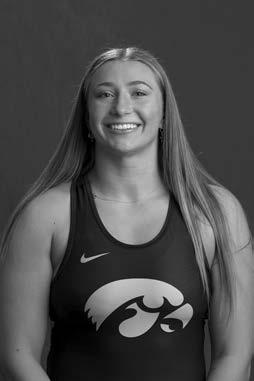
My coaches right now inspire me the most, especially Tanya [Verbeek] and [Clarissa] Chun, because they’ve done what I wanted to do. Having those two right in front of me is really inspiring, and they have all the knowledge that I need to get to where they were.
What is your favorite wrestling move? I like snapdowns a lot.
What type of music do you listen to before matches? Rap music, typically.
Patterson. Fans saw a sneak peek of these two sharing the load in Iowa’s contest against Missouri in the Music City Bowl.

Iowa will be returning most of its receiving core from last season, with Jacob Gill and Reece Vander Zee highlighting the position group, too. As a result, offensive coordinator Tim Lester — one year at the program under his belt has the experience and talent to finally get things right with an even better offense. There’s no excuse.
While Iowa is bringing back Xavier Nwankpa, Max Llewellyn, and Aaron Graves, the team will introduce new players to fill new roles on this side of the ball as it always does. I mean, this is Phil Parker we’re talking about. Even with the defense being somewhat of a question mark going into the new year, I believe this team is talented enough to earn eight wins. Offensively, I expect Lester and Gronowski to merge smoothly, continuing to develop on the offensive product built the season prior. There will be some concerns on the other side of the ball. But beyond Penn State and Oregon — both at home, mind you — this team isn’t facing anyone unbeatable. An 8-4 record is the floor.
6-6
Kylie Welker 180 pounds 5-foot-8 Redshirt second-year Franksville, Wisconsin Pre-business major
What is your favorite restaurant in Probably The Dandy Lion. I like their
What made you want to come to Iowa? It was an opportunity to move women’s wrestling forward. When I committed here, I was the first commit, so I trusted in Coach Chun and her abilities to create this program. It was really cool to be able to do that together.
If you didn’t wrestle, what other sport would you do?
I did gymnastics for eight years when I was younger, so I’d probably still be doing gymnastics.
The name of the game here is “realism” — never a term Hawkeye football fans want to embrace, but one every fan should. I don’t trust Gronowski after what happened to Cade McNamara. Sure, he’s a champion at the FCS level, but put him against Big Ten defenses. He was 10-of-26 for 87 yards when the Jackrabbits played the Hawkeyes two years ago. A passing quarterback hasn’t worked for Kirk Ferentz in ages. And removing Johnson from the equation seriously kills this offense, too. Without leaders like Jay Higgins and Nick Jackson on the other side of the ball, Iowa football will no longer be the defensive threat it was once known to be. We already saw some shaky secondary play this season that stung badly. Now do it without the dominant linebacker corps.
So, let’s get realistic with the schedule, too.
Cake-walk Albany and UMass wins will be interrupted by a loss at Iowa State on a roll after an upbeat 2024 for a 2-1 start. Remember, that game is at Jack Trice Stadium.
Wins at Rutgers and versus Indiana are expected to move Iowa to 4-1 to start, but don’t be surprised by a rivalry upset loss to Minnesota or at Wisconsin. It happens every year: Michigan State in 2024 and Minnesota the year before. Call it 5-2. Penn State and Oregon are both championship contenders again next season, so let’s not get cocky there — 5-4. The Hawkeyes wouldn’t have touched them no matter the location this season. Next year, I’d argue they’ll be even stronger. Hawkeye fans can only do so much. And if the trip to UCLA this past season was any indication, call it 5-5 with a loss at USC.
I’d hope the Hawkeyes beat Michigan State at home because that team is really going nowhere, but a trip to Nebraska to close out the season with Dylan Raiola burns the already massive holes in the Hawkeye secondary previously mentioned.
That’s 6-6. The personnel just isn’t there to make any noise next season. I hope I’m proven wrong.
Colin Votzmeyer Sports Editor Sports Reporter
Cody Blissett | The Daily Iowan
Iowa head coach Kirk Ferentz instructs defensive players during the TransPerfect Music City Bowl between Iowa and Missouri at Nissan Stadium in Nashville, Tenn., on Dec. 30, 2024. The Tigers defeated the Hawkeyes, 27-24.
letes. For us, having the access we need to tell these stories is the most important thing. We enjoy spending time with our teams and creating a relationship with them.”
Saunders oversees multiple units of content, including video, photo, graphic design, and liveevent production.
“We’d like to think it’s a little motivating for the team, but we just want to be a window into what they’re doing,” Saunders said. “At the end of the day, we’re trying to create good atmospheres for our fans and bring people into these cool moments.”
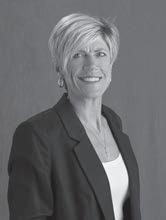
Iowa women’s basketball is an example of a sport that has seen heightened interest and popularity at Iowa. With the star power that is former Hawkeye Caitlin Clark, the Hawkeyes reached the national title game in back-to-back showings in 2023 and 2024.
Now led by veteran program member and new head coach Jan Jensen, Iowa has seen success this season, too, against such teams as Iowa State, Penn State, Kansas, and Drake, playing several of their games in front of a packed Carver-Hawkeye Arena.
The creative content team first gathered buzz on social media with its pregame hype video for the women’s basketball squad last season. In it, a violinist played to a boisterous song at Hancher Auditorium is featured while the players flexed before the camera — highlighted by Clark emerging from the darkness.
With pregame festivities designed to get a crowd on its feet, significant effort and hard
Peterson is 5-2 on the season with a loss to No. 27 ranked Adrian Meza of Iowa State and another loss to teammate Drake Ayala in the championship round of the Soldier Salute in late December.

work go into the media displayed at Carver. “There’s a lot that goes into it,”
Dalton Conrad, Iowa’s athletics video director, said. “A lot of time goes into picking the music and the overall vibe of what we’re going for for the specific project that we’re working on.”
With such a heavy media pres ence surrounding the court and filling press row at games, Con rad also noted how much time is spent sifting through material to find suitable candidates for publishing.
“A lot of hours go into sort ing through all the footage that we shoot,” Conrad said. “At any given basketball game, we can have up to four or five shooters. So, you can imagine how much footage that is. Picking those big moments from each game takes a lot of time to go through, but it’s also fun to relive those moments while we’re editing the pieces.”
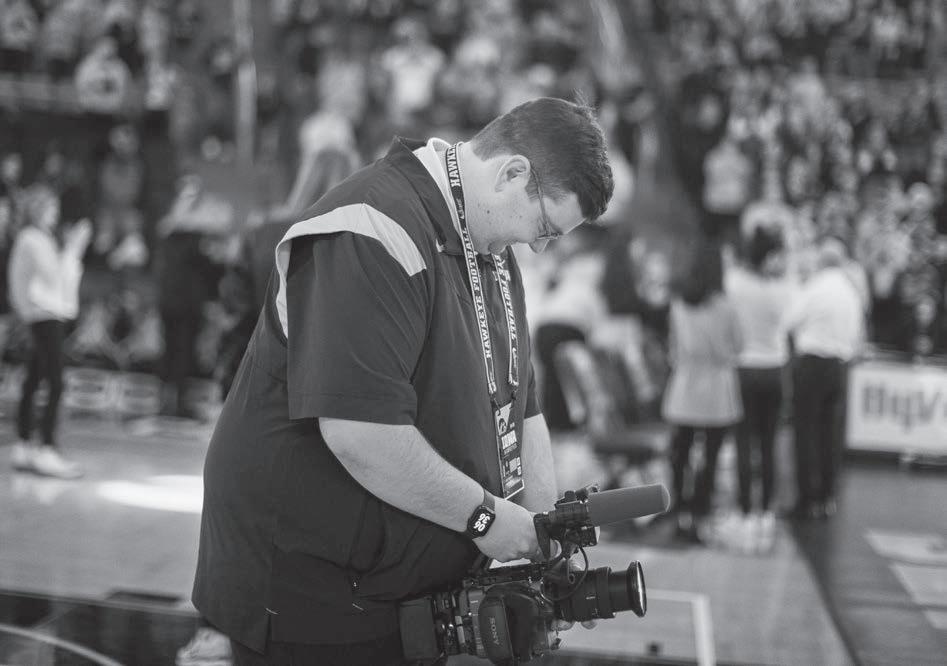
Carver-Hawkeye Arena sold out for the duration of the 2023-24 season with Clark’s sharpshooting abilities drawing fans in droves to see the Hawkeyes compete. When the Iowa Star entered the WNBA, some expressed skepticism over whether or not the fanbase would return.
Iowa fans’ fears were assuaged when the venue sold out yet again for the 2024-25 season, the news confirmed before the season had even officially begun. Jensen recalled this particular event fondly.
“That was a moment — a testament to all that was, really a testament to this fan base, of their belief in not only what was but what can be,” she said. “For the fans to be as excited as they were a year ago about such a
young and rebuilding and youthful perspective, that is just really cool.”
For fourth-year point guard Lucy Olsen, the transfer from Villanova and smaller crowds at Finneran Pavilion to the fanfare associated with Iowa and Carver was a drastic shift.
“At Villanova, I think our stadium held 6,000,” Olsen said. “We may have sold it out once or twice.”
Carver-Hawkeye Arena holds just over 15,000 seats, most of them filled for women’s home games.
“I look around every day, and I’m like, ‘All those seats?’” Olsen said.
Jensen has expressed gratitude for the work the school’s media
does to display the team and its successes, resulting in such energized environments come tip-off.
“They do a superb job showcasing our program with the work that they do,” Jensen said. “I really appreciate the efforts they make to elevate our brand on a daily basis.”
The strong partnership between the team and the media goes both ways, as Conrad expressed admiration for the people like Jensen who make these stunning media displays possible.
“I think we’re lucky in a way where we’ve had such legendary coaches that tell the story themselves,” Conrad said. “When Jan or Coach Bluder were speaking during their circle speeches that
they do, they really paint the picture. We just throw the clips over their speeches that explain what they’re saying.”
With the season underway and the amount of fans regularly attending games at Carver numbering in the thousands, Conrad, Saunders, and others continue the work they’re doing, getting the crowd on its feet for Iowa’s legendary programs for seasons to come.
“My favorite thing is working with these great people,” Saunders said. “At the end of the day, you want to do what you love — you want to do it with people you like being around. For me, it’s making memories and being at these big moments with good people.”
The pair of Hawkeye 125pound wrestlers have collected a cumulative record of 17-8 this season. If the Hawkeyes want to have a chance at the Nittany Lions in March, they will almost have to perform almost perfectly across the board, which includes the critical 125 bout.
With the Big Ten dual season already in progress, Iowa’s
On the other hand, Cruz is a respectable 12-6 on the season, owning losses to No. 27 Max Renteria of Oregon State and No. 22 Charles Farmer of Army. Cruz is 1-2 on the season in dual matches.
time is dwindling to find the right lineup that will give them the best opportunity to win the national title. The Hawkeyes looked every bit a contender in the conference opener against Wisconsin on Jan. 12, winning in a 45-0 sweep. Brands again discussed lineup changes after the dual, specifi cally at 141 pounds. Second-year Jace Rhodes earned the start, but fourth-year Cullan Schriever could join the mix if needed.

“Schriever could have went at 141,” Brands said. “Those two guys [Schriever and Rhodes], we have confidence in both of those guys. Rhodes was in his first Big Ten dual. Schriever has been on the mat more. And it was my call. It was my call.” Rhodes took advantage of his opportunity and claimed a 6-3 decision over Brice Bobzien. While Rhodes admitted it wasn’t the prettiest victory, he was still pleased with his performance. His triumph was also his first-ever Big Ten win. “I liked the first period. In the second half, I let up a reversal. Not exactly ideal,” Rhodes said. “Overall, it was a gutsy win, and I was glad I could pull it out to keep giving myself opportunities to go out there and win.”
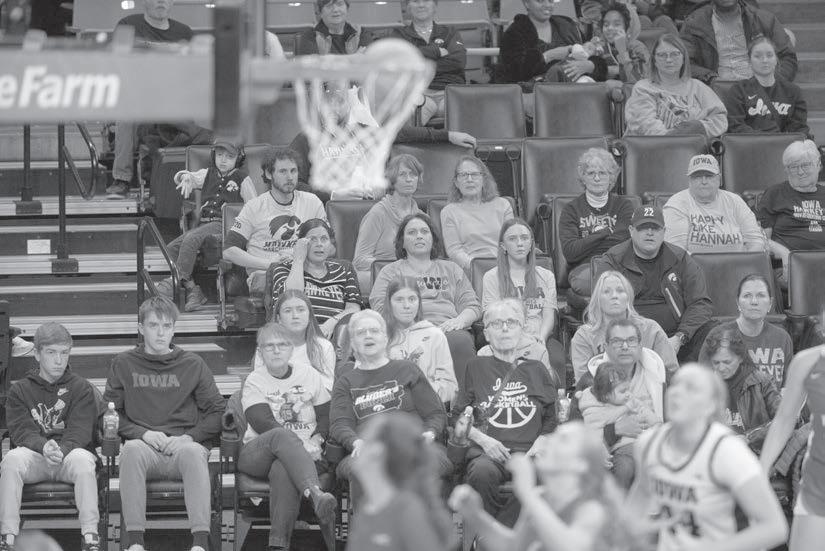
responded well against Indiana despite falling short.
“After the Illinois game, I was very hot and disappointed with their play,” Jensen said at media availability on Jan. 15. “I just saw a little flatness for the first time. At Indiana, they really did battle. We closed gaps a couple of times. We just didn’t turn a corner. But I saw a different type of feel.”
Though it’s technically her first year as head coach of this squad, having spent more than two decades alongside Bluder and this program as the associate head coach made her more than prepared for the role.
Jensen said she understands there’s still a big learning curve to what looks like a completely different team. Lucy Olsen spent her past three years across the country at Villa nova, Addison O’Grady and Taylor McCabe were thrust into more prominent roles, and the three freshmen in Taylor Stremlow, Tea gan Mallegni, and Ava Heiden are seeing more minutes than most anticipated.
And with Clark, Kate Martin, and Gab bie Marshall out of the program, players like Sydney Affolter, Kylie Feuerbach, and Han nah Stuelke are now the ones leading the l ocker room.
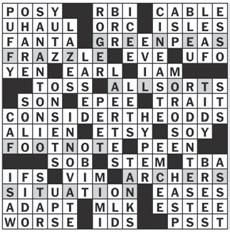
“You think about the experience you have on the floor,” Jensen said. “Kylie has been here for a while, but I think she’s stepping up into a new leadership role. You think about those like Sydney and Hannah that’ve had a little bit of that experience playing in the Big Ten. I think that’s kind of who we’re leaning on in terms of those leadership roles right now.
“You’re probably looking at it like we’re a lot farther away than we’re close, and I kind of look at it like we’re a lot closer than we’re farther away,” she added.
Iowa is currently sitting outside the AP top-25 rankings after spending the last three seasons near the top of the list. But those within the program have zero doubts about their ability to overcome the adversity.
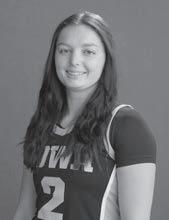
“We got to find a way to bounce back and snap that,” third-year guard Taylor McCabe said. “I just think this team is so different, and I don’t think that we ever stopped fighting. That Iowa culture is definitely still there.”




Emma Calabro | The Daily Iowan
Fans watch as the ball falls through the net during a women’s basketball game between Iowa and Washington State at Carver-Hawkeye Arena in Iowa City, on Nov. 24, 2024. The Hawkeyes defeated the Cougars, 72-43.
| The Daily Iowan
photo, and other elements.
Jensen
Conrad
McCabe
Rhodes
CARVER-HAWKEYE SEND-OFF
The Iowa Hawkeyes defeated Augusta College and Grand Valley State University in the team’s final home dual at Carver-Hawkeye Arena on Jan. 18. Iowa’s victory was followed by senior recognition for the Hawkeyes’ four graduating members.
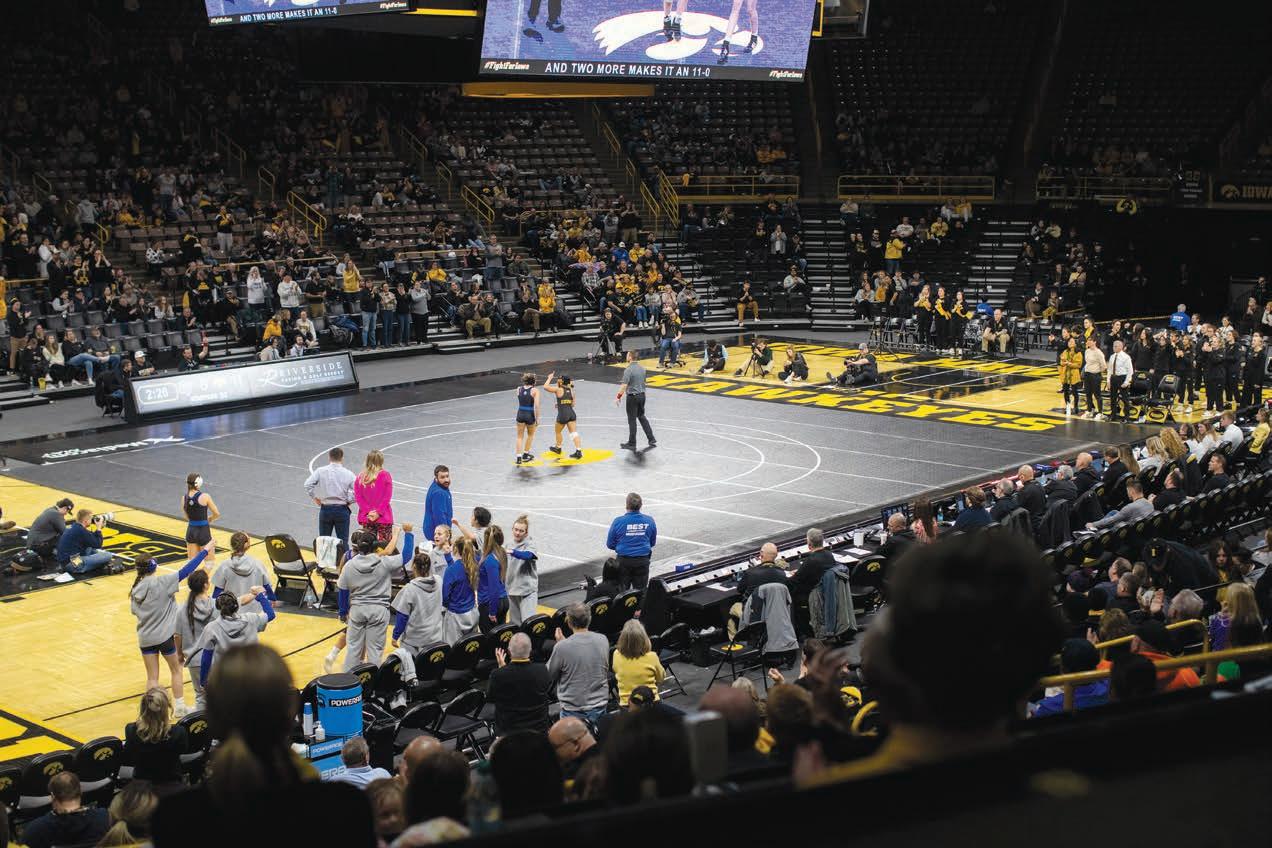
DUAL STATISTICS
Top-ranked Iowa scored the most team points with 77.
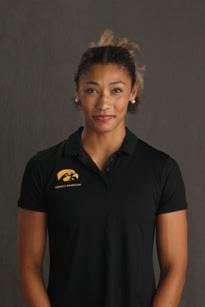
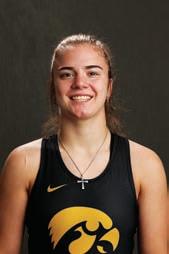
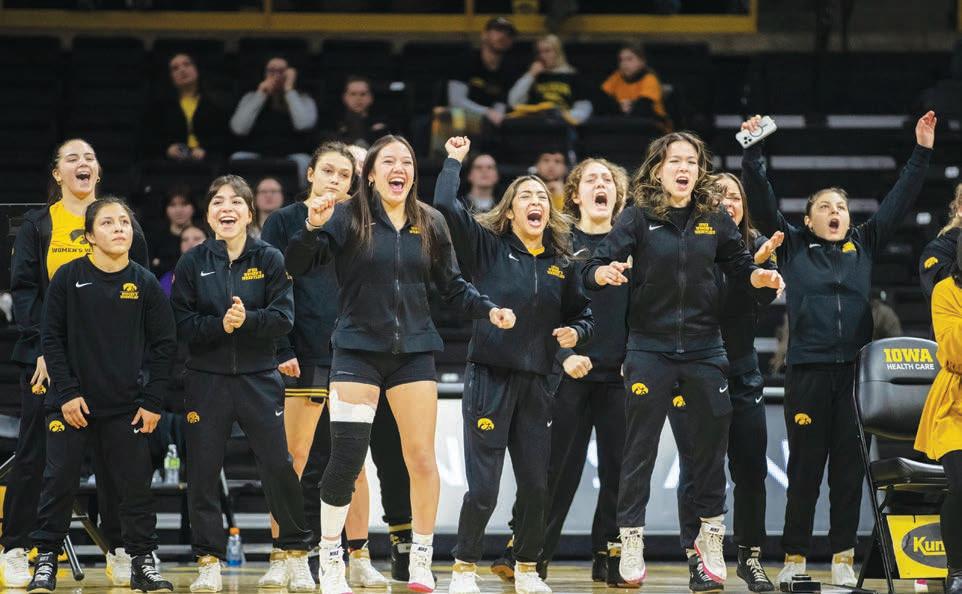
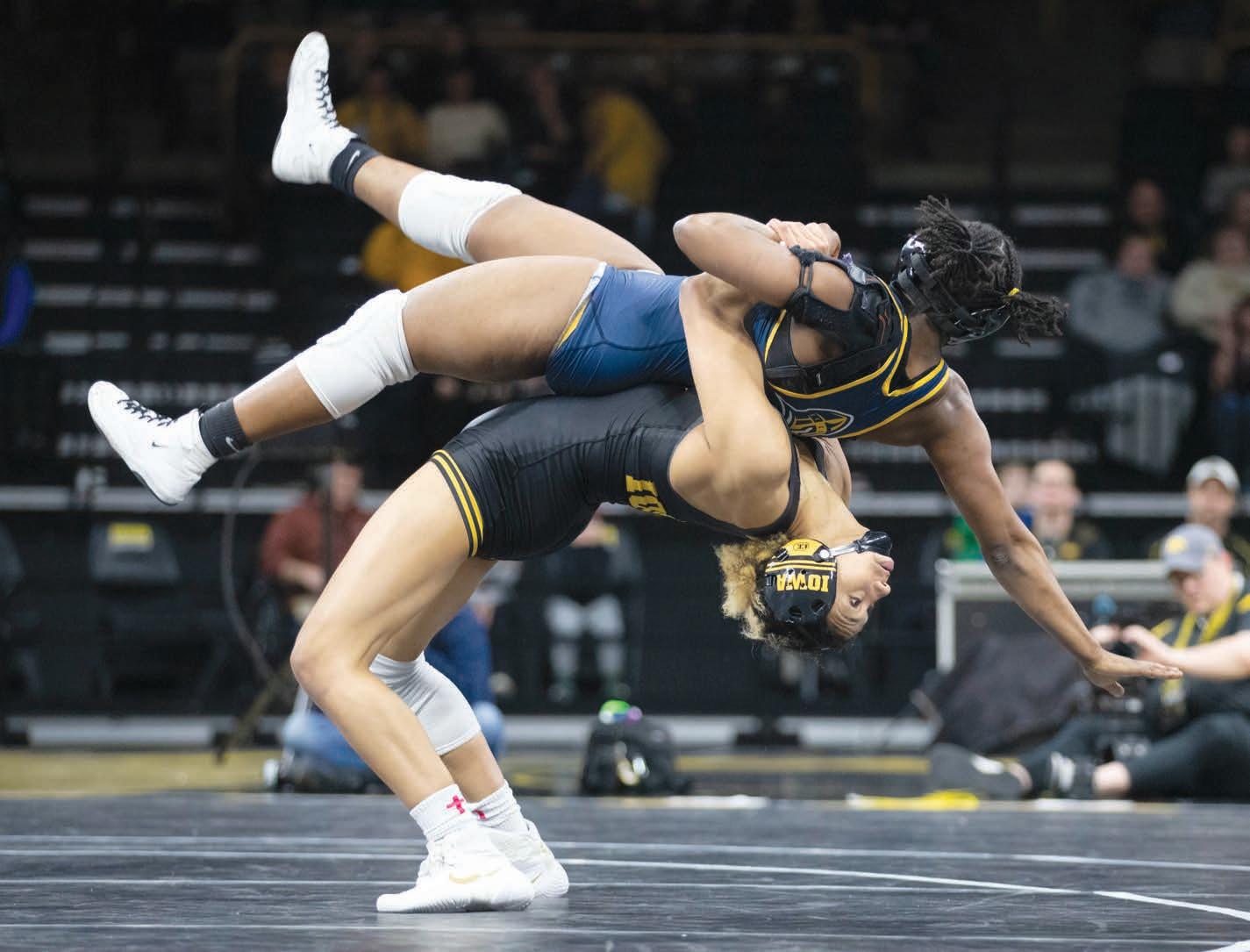
Isabella Tisdale | The Daily Iowan
(Top) The Iowa Women’s Wrestling team walks onto the mat before a match against No. 4 Grand Valley State University at Carver-Hawkeye Arena. The team defeated Grand Valley State University, 35-7. (Middle) Iowa No. 1 117-pound Brianna Gonzalez celebrates after defeating Grand Valley State Kiely Tabaldo in a match. Gonzalez defeated Tabaldo by technical fall, 11-0. (Bottom) Iowa No. 1 160-pound Kennedy Blades throws Maryam Ndiaye of Augustana College during a match. Blades defeated Ndiaye by technical fall, 13-0.
KENNEDY BLADES had the fastest fall of the day in 38 seconds
REESE LARRAMENDY and Blades led Iowa in single match points with 13 each
ARTS & CULTURE WEDNESDAY, JANUARY 22, 2025

Charlie Hickman Arts Editor charlie.hickman@dailyiowan.com
Kyrsten White Arts Reporter arts@dailyiowan.com
Everybody is a fan of something — from authors to singers to quarterbacks — but for some, the fandom becomes a second life. These fans are often considered “stans,” and as people have been forced further online after the COVID-19 pandemic, stan culture has grown exponentially.
“Fans have this thing that is a part of them, but stans understand the world through the lens of the thing they stan. The difference is being able to step out as opposed to being engrossed in,” Corrine Jones, a media studies doctoral student from the University of Iowa, said.
Jones’ studies center on music fandoms, analyzing how fans of musicians discover social issues and the nuances of identity through their favorite artists. In her work, she has found a correlation between the COVID-19 pandemic and an increase in online stan culture.
“People were looking for community, spaces to discuss things they were interested in. Online digital life was all we had access to, so [fandoms] really took off in those pandemic years,” Jones said.
The word “stan” was popularized by Eminem in 2000. In his song
“Stan,” Eminem tells the story of a fan who takes things too far when his idol doesn’t answer his fan mail.
Believed to be a cross between the word “fan” and “stalker,” the word has been a part of popular culture for over 20 years. In the era of online fandoms, the word has gone from an insult to a symbol of status in a fanbase.
“When you’re idolizing a celebrity, you lose track of the fact they’re just people,” Jones said. “They’re always going to make mistakes or do something wrong. People aren’t perfect. Even if you stan the most politically minded, smartest person in the world, there’s still the chance they’ll do something not great.”
With the lack of human connection brought on by the pandemic, many people in fandoms who call themselves stans developed increasingly parasocial relationships with the celebrities they idolized. The people most likely to be in online fandoms are young people who don’t yet have a fully developed sense of identity, making a parasocial relationship even more dangerous.
“A lot of stans are in transitional periods of their lives or figuring out their identities, they’re looking for something to get lost in,” Jones said. “When Sabrina Carpenter tweets about her relationship every day and stans reply and she responds, there’s an implied relationship there to the stans.”
‘Sanctuary’ recounts local church’s journey toward LGBTQ+ inclusion
Tom and Adey Wassink, leaders of Sanctuary Community Church, talk about their journey to include the LGBTQ+ community in their congregation.
Emma Isenhart Arts Reporter arts@dailyiowan.com
Queering a Church in the Heartland is a moving story about how one Iowan church found its way from exclusion to inclusion and ultimately grew deeper in its faith. Documenting their transformation and struggles along the way, Adey Wassink and Tom Wassink share their insights on including the LGBTQ+ community in their congregation and the impact it has had on their church’s health. Sanctuary was published on Oct. 8. This interview has been edited for length and clarity.
The Daily Iowan: Some may believe Iowa is nothing more than cornfields and conservatism, but Iowa City is distinctive from that view. What can you tell me about Iowa City, and what makes it so special?
Tom: Well, we came here from the Chicago area for me to do training [for the church] and didn’t expect to stay more than two years. At that time, we were a part of a conservative religious denomination, and when we got here, we were still connected to that, but much less tightly. We were surrounded by this city that embraced liberal progressive values amid conservatism. The generosity of people and the openness to new ideas and possibilities surprised us. Being in Iowa City opened us up to a new way of doing church and of practicing religion. Instead
of scrutinizing, it presented a notion of God that was generous, open, welcoming, and really for the people. That was due to the politics and the social atmosphere we found in Iowa City.
Adey: Having a Black, gay mayor as the face of Iowa City feels like a statement of who you are and that everyone is welcome here. It encourages or invites that kind of openness.
Tom: Religion thinks it’s supposed to know the answers and not be shaped by culture. The distinction is religion influences culture and not the other way around.
What advice do you give to other congregations wanting to implement this kind of change for themselves?
Tom: When we first started, conversations were the most important thing. Whatever stage we were at, we would invite our staff and people in the church to initiate conversations and expand our horizons. These were uncomfortable meetings where we talked about things people would rather not. It was through these conversations that we were able to go from a place of comfortable exclusion to celebrating inclusivity.
Adey: If you’re a church practicing exclusion and want to become inclusive, it’s not just saying you are and letting some more people come. It’s a throughand-through deconstruction and reconstruction of what it was about your faith that made it possible to exclude in the first place. In the new practice
Survive the snow in fashion
Stay warm and stylish during the coldest months of the year with these trending pieces of outerwear.
Isabelle Lubguban Arts Reporter arts@dailyiowan.com
As the crisp fall breezes ebb away to make room for the icy hands of winter, it is important to stay on top of outerwear to get through the snow in style. December gave us a hint of the ice storms and snowy sidewalks we can expect for the rest of January and February, so now is the perfect time to assess your wardrobe and be sure you are prepared.
Oversized Scarves
Demand has never waned for one of winterwear’s prime forms: the scarf. Specifically, the ones that are so oversized they are often compared to the average blanket by retailers. The much-loved garment has been used for centuries, so why fix it if it isn’t broken? Many different textures and patterns have been mixed, layered, and rearranged as scarves have come and gone from the fashion world.
In 2012, singer Lenny Kravitz was seen walking the streets of New York City in a brown scarf that almost swallowed his torso. The sight of him took the internet by storm, giving rise to thousands of memes and social media posts. It is unsurprising to see Kravitz in a scarf, but this one was more than five sizes bigger than his usual lineup. His fashion choice that day was such an engrossing topic that it inspired a scarf movement.
In the last decade, the scarf bandwagon has expanded. In 2021, high fashion brands such as Loewe and Acne Studios included them in their collections, using fabrics like mohair, wool, and cashmere to promote warmth during winter’s harsh conditions.
Aside from the scarf’s fashionability, its versatility allows people to wear it in different styles. A secure style is the oneloop knot, which is when it is wrapped
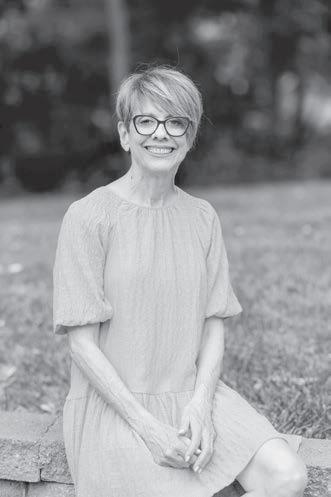
of Christianity, we feel like exclusion isn’t even possible. It’s not conceivable. It’s not just being who you are and then letting some people come, which is what we thought it would be in the beginning. Everything changes.
As a straight couple, what have you learned about being allies to the LGBTQ+ community?
Tom: A big part is just entering into their stories. The LGBTQ+ community desires participation in religion for a place where they can encounter God. I grew up in a culture where queerness was pushed out, so it wasn’t even present. A big part of it for me was coming into familiarity with the people my culture had turned away who turned out to be just like me. All their desires, hopes, aspirations, and what they wanted from faith, were just like mine. Another part was just genuinely letting a little bit of queerness into our lives that wasn’t there before. There aren’t these absolute dichotomies of identity and of the experience of gender, so letting that be the case for us has been lovely.
Adey: Many gay people who have attended church have been severely harmed. I don’t think we could have predicted the pain that we would encounter, so hearing that and letting it be real was important. We’ve been entering that space of pain and brokenness by offering pastoral care, or whatever it is, but also realizing that the harm Tom and I have suffered pales in comparison. As a scientist, sometimes Tom would say, “My brain isn’t welcome in religion,” or as a female, my sex isn’t welcome as a pastor, but nothing compares
and Tom Wassink
to the harm that has been done to gay people in religious institutions.
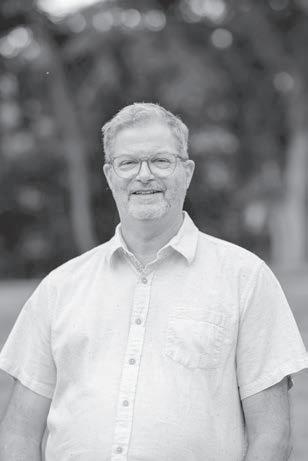
If you could go back to the very beginning of this journey, what would you tell yourself?
Adey: Well, I think I would tell myself to stick with it, because whatever the cost of this, the liberation, the way, the truth, the light, that we find on the other side will be more expansive, more valuable, and more bright than the struggles. It feels like our hearts have exploded. And then all we knew was, “Oh my gosh, we might blow up our church. We’re going to lose these people. We’re going to lose these friends. We’re going to lose these givers.” I would tell myself, “You’re right.” You might lose some of those things, but what you get on the other side is true life.
Tom: When you’re on the front end of transformation, all you face is the hardness of change, the things you lose, and the work you’ll have to do. We can’t know what it will be like to be on the other side until we’re there, and it’s amazing. I mean, our experience of being pastors is infinite. We have changed into people who we like better than who we were 15 years ago. And then there are the people who are coming now who couldn’t have come before. It’s inconceivable to us now that they wouldn’t be a part of our church family, a part of our lives. So, it’s just amazing. It’s liberating. It’s joyful. To us, our practice of Christianity feels closer to what we think it’s supposed to be.

BOOK


Obsession directed by Brian De Palma
around the neck once, and a small knot is tied in the front. Another way to wear it is like a makeshift hat, protecting not just your neck but also your ears and head at the same time.
Puffer Jackets
With styles that eerily resemble the Michelin Man, puffer jackets have always had an established prominence in the outerwear world.
Before it made its way to the fashion industry, the jacket was prioritized for its functionality. Its first appearance was in 1922 on an aspiring Mount Everest climber named George Finch. The garment was custom-made of hot air balloon fabric and deemed an “eiderdown coat.”
Just 10 years later, outdoorsman Eddie Bauer created the first puffer jacket to replace the woolen one that froze and gave him hypothermia during a fishing trip. This alternative was made with duck feather filling and quilted fabric that boosted insulation and trapped body heat inside.
High-end fashion labels like Gucci and Louis Vuitton recently released their first-ever ski collections, and in the middle of them all were none other than puffer jackets. In 2019, Lyst, the world’s largest fashion search platform, ranked The North Face’s Nuptse puffer jacket among their hottest products of the year.
Some famous faces have also taken the jacket into their wardrobes. Robert De Niro’s character from “Taxi Driver” was channeled through supermodel Bella Hadid, who wore a puffer made by designers Arben and Kuj Durollari while volunteering to help the homeless. Singer Billie Eilish made a statement in February 2021 when she showed up to her film release “Billie Eilish: The World’s a Little Blurry” in an oversized taupe Gucci x The North Face puffer jacket patterned with little horizontal s-shaped insignias.
Events back from break
As the spring semester begins, here are plenty of events to keep you busy.
Charlie Hickman
Arts Editor charlie.hickman@dailyiowan.com
Panel Discussion: Tough Conversations About Our Racial Divide…and How We Can Begin to Heal — Feb. 1, 1 p.m. at Iowa City Public Library, 123 S. Linn Street
Authors Dave Markward, Daniel Henderson, and Steven Torriano Berry will discuss their recently published novels, all of which discuss how racism influences different communities in different ways.
MLK Week: Art and Expression Day at the Stanley — Jan. 3, 10 a.m. - 8 p.m. at Stanley Museum of Art, 160 West Burlington Street
The University of Iowa is hosting events in correlation to MLK Day all week. On Thursday, the Stanley will host a collaborative community mural painting event with guest artists Thomas Agran, Miriam Alarcón Avila, and Erykah Danner.
Musical: Hadestown — Jan. 24 - 26, Hancher Auditorium, 141 Park Rd.
Hancher’s Broadway series returns this weekend with “Hadestown.” The awardwinning Broadway musical opens at 7:30 p.m. on Friday with additional shows at 2 p.m. and 7:30 p.m. on Saturday and 2 p.m. on Sunday.
Film: Cycling Without Age — Jan. 26, 4 p.m. at FilmScene at the Chauncey, 404 E College St.
FilmScene’s community collaborations series returns this weekend with a collaboration with the Iowa City Bike Library. The documentary short film will include a Q&A.
Performance: Gathe Raho — Feb. 1, 6:30 p.m. at The Englert Theatre, 221 E Washington St.
The UI Indian Student Alliance holds an annual a cappella competition that brings together seven teams from across the country. The music combines Western and South Asian styles for a unique audience experience.
Music: The Squares, The High Council, and Next To Midnight — Jan. 25, doors open at 8 p.m. Gabe’s, 330 E Washington St.
Contributed by Susan Stitt of Adey
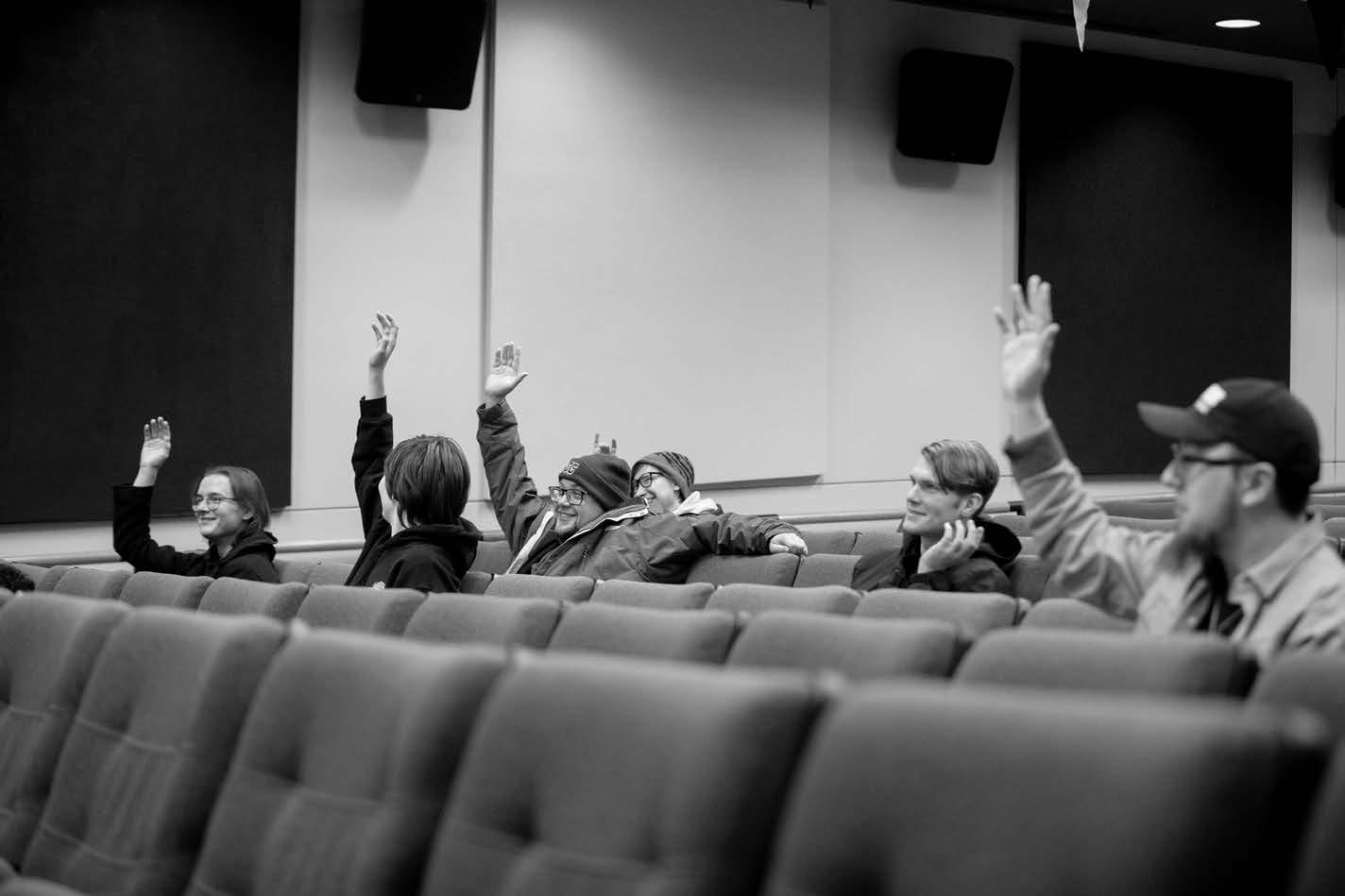
The internet has provided unprecedented access to the lives of celebrities. Pop stars film TikTok behind-the-scenes videos, actors show off their exercise routines, and musicians host live streams as they experiment with songs.
As fans have been pushed further online, they’ve been more and more exposed to this kind of content, making them feel closer to celebrities.
While the parasocial consequences of stan culture can be detrimental to the mental health of stans, Jones clarifies there is plenty of value in fandom.
“Taylor Swift is a great representation of how these younger fans are introduced to social issues,” Jones said. “She reaches people who are hearing about feminism for the first time.”
Taylor Swift may not be the most politically radical voice, but Jones is optimistic that incorporating any sort of social messaging in music is still impactful.
“Celebrity feminism is its own microcosm. It is so divorced from the political base of feminism. This doesn’t mean we completely discount it, though,” Jones explained. “They get attention, and in the attention economy, that is everything.”
One of the most popular singers on the planet runs a monthly book club that has continually grown since it started in 2023. Dua Lipa’s Service95 book club shows how celebrity influence doesn’t always mean selling merchandise.
The books in Lipa’s club are often works of literary merit and give diverse authors a platform to discuss their work in interviews with the singer. Not every celebrity can run a book club, but Service95 is one example of how influencers can make a difference and promote thoughtfulness within their fandoms.
“It’s not like Taylor Swift says the word ‘feminist’ and suddenly we’re all feminists,” Jones said. “It can inspire people to start reading feminist literature and look into the heart of the issue. Celebrities being active in politics is an incredibly important part of our politics.” Jones is unsure of whether that amount of influence is positive or negative, but she is sure it’s there. Her studies into what that influence produces come from personal experience.
“I grew up in Iowa, and no one really talked about social issues. Now, the girls from my hometown know what feminism is. Even if they aren’t burning their bras, they have a base-level understanding that will become deeper,” Jones said. Being a fan of something has an impact one’s personal life, too. The basis of being part of a fandom is that people enjoy being around people with similar interests. While stan culture can be toxic, fan culture is often healthy.
“When you’re a fan of something, you appreciate but don’t go past an extent,” Muchael Gura, the UI’s Anime and Manga Club president, said. “You get posters of your favorite games or shows in your room, you decorate your office with an artist you like, stuff like that.” Expressing fandom is a large part of

the appeal. Wearing clothes or decorating a room in fan memorabilia is a way to connect with other fans.
Gura said Iowa’s Anime and Manga Club is a casual collection of fans. Every Friday at 6 p.m. in the Iowa Theater within the serpentine halls of the IMU, anime enjoyers meet up to group-watch a votedupon show.
In the same way the online side of fandoms can become obsessive, fan expression can, too.
“If your entire room is covered in pictures of Taylor Swift, that is probably crossing a line,” Gura said. “But I don’t exactly know where that line is. It’s different for different people. It’s important
“Our group is really healthy about that stuff. We’re fans of anime or manga. We just like the medium. So, when we vote on what show we want to watch next, pretty much everyone is onboard,” Gura said.
Gura’s Anime and Manga Club is just one of dozens of fan clubs around campus that offers a community of people with similar interests.
The UI’s K-pop dance group, Hallyu, is another organization on campus that promotes healthy fan behavior. With about five groups of dancers, plus an audition-based group, they hold multiple performances throughout each semester.
While this group does give other fans of K-pop a space to enjoy the culture,
“I grew up in Iowa, and no one really talked about social issues. Now, the girls from my hometown know what feminism is. Even if they aren’t burning their bras, they have a base-level understanding that will become deeper.”
Corrine Jones
Media studies student from the University of Iowa
to think about whether or not what you’re doing is counterproductive to the rest of your life.”
Being a fan of something alongside other people can be a way to prevent the downsides of stan culture. There’s a sense of accountability when you enjoy a fandom with other people.
If certain behaviors are isolated, fans might consider their bad habits normal. Enjoying a favorite show or musician with other people can provide a healthier example of what fandom looks like.
Mia Tang, a member of the group, acknowledged there can be different sides to stan culture.
“If you have the right people around you, it doesn’t really matter if they’re a stan. But the word ‘stan’ also does come with some stereotypes,” Tang said.
The word itself is mostly used on social media, the most common sighting being on X, formerly known as Twitter. Tang described how the app has many wellknown stan groups, K-pop being one of the bigger ones.
As she believes being a stan is not always a bad thing, there are many times when using the app that she noticed how the groups can create unhealthy spaces on X. A platform once meant to allow users to share their favorite songs or moments has become one full of arguments over artists.
Talia Hill, the face behind the UIowaSwifties Instagram page, has had many issues with stan groups across social media.
“I was called a homophobic slur because I said I didn’t like a Camilla Cabello song. And it was from someone who has a faceless account online,” Hill said. The ability to hide behind a screen makes it easier for stans to attack others for having different opinions than themselves. This creates toxic environments that steer others away from big fan groups.
“Stan culture has made it so that it’s impossible for people to criticize an artist,” Hill said.
Despite the nuanced impacts and reasons for fan culture to be growing increasingly extreme online, fan culture around Iowa City remains strong. Clubs around campus and active online fans are promoting healthy expression no matter what they’re fans of.
Gura has been watching anime since he was a kid. Jojo’s Bizarre Adventure and Naruto are his two favorites, and he’s loved being able to continue the tradition of watching them with the Anime and Manga Club.
“Those shows kind of grew up with me,” Gura said. “Now I have good memories with these shows, watching them with friends.”
Keeping New Year’s resolutions strong at the UI
Students at Iowa discuss their experiences committing to
Third-year student Luke Ziolkowski was playing video games one day over winter break when a thought occurred to him.
Ziolkowski, an English and creative writing major, had been keeping a journal for almost a year and a half but had become inconsistent in the habit of using it. Writing itself wasn’t the issue — it was getting into the mindset of writing that presented a challenge. Upon making this discovery, and realizing he hadn’t written anything over break, he decided something needed to be done.
With the new year on the horizon, Ziolkowski said it was a good time to try and make a change. He doesn’t normally indulge in yearly resolutions — he lamented that he often hears people joke about seeing the gym more crowded in
January — but this year, he decided to give it a shot.
“Obviously, you can do that kind of stuff whenever.
That’s kind of why I don’t normally do resolutions. It’s just that I have the mindset of, ‘If I want to change something, why not just do it before New Year’s?’” he said. Ultimately, Ziolkowski believes if adding the label of “New Year’s resolution” encourages more people to aspire for change, then there’s no harm.
“As long as it works,” he said.
Dylan Popish, a third-year UI student studying screenwriting, found himself in a similar situation.
During a recent visit with his therapist, he developed a particular system that he realized could be worked into a New Year’s resolution. He developed a list of healthy activities that fall to the wayside all too often including exercising, eating well, reading more books, and cleaning his apartment.
From there, he decided to keep a log to see how many days
he ended up doing the things he wanted to do.
This way, he said, he could keep his resolution for as long as possible rather than have it fizzle out in the middle of January like resolutions so often do.
The main idea, he said, was to continue pursuing these healthy activities for as long as possible. Even if he broke the streak and missed a day or two, he would be committed to picking them back up.
Popish’s goals in many ways align with the majority of people who make resolutions. According to Drive Research, adults aged 18-24 are more likely to base their ambitions around fitness and well-being with 53 percent of this group planning to exercise more and 51 percent to eat healthier. College students are more likely than most people to make a New Year’s resolution centered around health and wellness, as experienced by Popish and Ziolkowski.
“I didn’t want to just do one thing. My goal was to just be healthier in general,” Popish said. “I have the passive goal of doing these healthy things as much as I can.”
Hannah Neuville | The Daily Iowan
Members of the University of Iowa Anime and Manga Club vote to watch the anime “Saga of Tanya the Evil” at their weekly meeting in the Iowa Theater at the Iowa Memorial Union on
Dec. 6, 2024. The club votes on which anime to watch and discuss at the start of their meetings.
Hannah Neuville | The Daily Iowan
Members of the University of Iowa Anime and Manga Club watch the anime “Saga of Tanya the Evil” at their meeting in the Iowa Theater at the Iowa Memorial Union on Dec. 6, 2024. President of the Anime and Manga Club Muchael Gura, began watching anime as a kid.
‘The Brutalist’ constructs a masterful experience
Brady Corbet’s Golden Globe-winning film reaches for
Charlie Hickman Arts Editor charlie.hickman@dailyiowan.com
When I go to a movie, I want to be entertained, or I want to be challenged. “The Brutalist” is the rare film that made me feel both.
Brady Corbet’s Golden Globe-winning “The Brutalist” portrays something we don’t often see in film today: someone reaching for greatness.
It feels like we’ve existed in a filmmaking landscape in which “The Godfather,” “Citizen Kane,” and “There Will Be Blood” have been put on a pedestal and hailed as masterpieces for a while now.
Movies emulate the thematic and technical ideas of those films all the time, but I believe “The Brutalist” is trying to earn
a spot on that pedestal. Only time will tell if it can attain that status.
It is a special experience to live in a film that feels so confident, so in conversation with its influences, yet so electrifyingly new. The film tells the story of a Hungarian Jewish immigrant, played by Adrien Brody, who is hired by a Philadelphian oligarch, played by Guy Pearce, to design a community center.
That story may sound simple, but it’s the relatively straightforward plot that allows the film’s visual and thematic ideas to sing.
László Tóth, the protagonist of the film, is faced with remnants of his acclaimed Brutalist architecture work in Budapest through newspaper clippings — work he will never see again after the fallout of World War II. As Tóth tries to continue his work under a
new proprietor named Harrison Van Buren, he struggles with the dueling instincts to work for survival and work for legacy. Tóth’s relationship with Van Buren grows contentious as the design and construction process draw on, calling into question the relationship between an artist and a commissioner, art as utility or aesthetic, and who truly owns a work of art.
Much of the film follows Tóth as he acquires the materials he needs to craft his magnum opus, despite Van Buren’s business associates’ insistence they go cheaper. A running theme of the film is to build with the best materials available, a philosophy also applicable to the film’s production.
Director Brady Corbet and his wife Mona Fastvold wrote the script together seven years ago. Much of the time between then and now was spent in pre-production procuring the film stock and VistaVision cameras Corbet wanted. The film was shot entirely on location across Europe, in Italian quarries, and on gorgeous, sprawling hills.
Produced for only $10 million, the film is a testament to independent filmmaking. The love and care indie filmmakers feel for any passion project shine through in every gorgeously composed frame of “The Brutalist.”
Seeing it projected on 70-millimeter film added to the handcrafted feel. Audiences can see the human labor as the picture
slightly stutters, letting them know the projectionist just switched the reels, and the beautiful film grain dances across the screen. Despite its three-and-a-half-hour runtime, the film is brilliantly structured with an Overture — which was so aweinspiring I considered sitting through the entire film again — two chapters, an intermission, and an epilogue. The intermission was a great way to make the experience more palatable and provided an opportunity for audience members to discuss the film with friends and strangers alike.
I was hesitant about the runtime before the film, but Corbet establishes the pace with the title sequence early on. As the music crescendos and the title bursts onto the screen, audiences see a shot from a car’s point of view as it cruises down a country road. This gliding, whizzing pace is maintained throughout the film and makes the viewing experience totally engrossing. A film as massive in scale yet so intimate in scope is rare. It’s a mature story about America, art, place, and capitalism. This review doesn’t scratch the surface of the immense cinematic exhilaration I felt by the time the film was over. It’s a lot to fit in your head, which makes it all the more impressive Brady Corbet and his team accomplished this feat of filmmaking.
The Daily Iowan’s 2025 Oscar nominee predictions

Best Picture: “Anora”; “The Brutalist”; “The Substance”; “Conclave”; “Emilia Pérez”; “Wicked”; “Dune: Part Two”; “A Complete Unknown”
Best Director: Sean Baker (“Anora”); Brady Corbet (“The Brutalist”); Coralie Fargeat (“The Substance”); Jacques Audiard (“Emilia Pérez”); RaMell Ross (“Nickel Boys”); Edward Berger (“Conclave”) Best Original Screenplay: “Anora”; “A Real Pain”; “The Substance”; “The Brutalist”

Best Adapted Screenplay: Boys”; “Wicked”; “Emilia Pérez”; “Conclave”
Best Actress: Mikey Madison (“Anora”); Cynthia Erivo (“Wicked”); Demi Moore (“The Substance”); Karla Sofía Gascón (“Emilia Pérez”); Fernanda Torres (“I’m Still Here”); Nicole Kidman (“Babygirl”)
Best Actor: Daniel Craig (“Queer”); Timothée Chalamet (“A Complete Unknown”); Ralph Fiennes (“Conclave”); Sebastian Stan (“The Apprentice”); Adrien Brody (“The Brutalist”)

If it’s not already obvious from my lineups, Anora is my favorite film of the year and the first that comes to my mind for award-sweeping, but my predictions are in no way reflective of all the hard work and talent devoted to the films released this year.

before placing a bet or what solvers must do to fully appreciate each starred clue 43 “Take me to your leader” speaker
Handmade



“The Brutalist”; “Nickel Boys”; “Conclave”; “Emilia Pérez”; “Anora”; “Wicked”; “A Complete Unknown”; “Sing Sing”; “All We Imagine As Light”; “A Different Man” Best Director: Brady Corbet (“The Brutalist”); Sean Baker (“Anora”); Jon M. Chu (“Wicked”); RaMell Ross (“Nickel Boys”); Payal Kapadia (“All We Imagine as Light”); Jacques Audiard (“Emilia Pérez”) Best Original Screenplay:
“A Real Pain”; “The Substance”; “The Brutalist”; “A Different Man”; “Anora”; Best Adapted Screenplay: “Conclave”; “Emilia Pérez”; “A Complete Unknown”; “Nickel Boys”; “Queer” Best Actress: Mikey Madison (“Anora”); Demi Moore (“The Substance”); Karla Sofía Gascón (“Emilia Pérez”); Marianne JeanBaptiste (“Hard Truths”); Fernanda Torres (“I’m Still Here”)
This has been a weird year in movies, and I think the Oscars will reflect that. As you can see in my list, I think several films will barely make the cut with one or two nominations. I don’t think there is a clear frontrunner, which is exciting and will give some smaller, lesserknown films a chance to shine.
competitor
45 Main ingredient in many veggie hot dogs
46 *Book designer’s concern
48 Hammer part 50 Sad sound
51 Morel support?
53 “Check back later,” in brief 56 Hypotheticals
59 Pep
61 *Ones with good aim
63 *Mess that might be sticky 66 Makes tolerable
67 Change with the times 68 Deliverer of the speech “Beyond Vietnam: A Time to Break Silence,” for short 69 First name in cosmetics
70 Response during an eye exam
71 Cards
72 “Hey, I’ve got a secret …”
Down
1 Like eyes after a good cry
2 Midwest hub
3 Southwest point of the Texas Triangle
4 Fool, from the Yiddish
5 “Understood” 6 “It’s so c-c-cold!”
7 Refreshment served with a spoon straw
8 Film buff
9 Menace hiding in a basket of figs in “Antony and Cleopatra”
10 “Sacre ___!”
11 Table expander
12 Sylvan (electropop duo)
14 Vegges out 19 Satanic 21 Zapped with light
26 Ophelia’s vengeful brother in “Hamlet”
28 Eeyore-like
30 Beginnings
32 Gives permission to 33 Parts of many home inspections
34 In good order
35 Pike and Pine, in Seattle: Abbr.
36 Brand of party cups
38 Actress Amanda
40 Lunchroom, casually
41 Think outside the box
42 Like many kids post Halloween
47 “In memoriam” piece
49 Play the host
52 Sleeveless shirts, informally
54 Longtime Saints QB whose name has a windy homophone
55 Item in the plus column
56 “You don’t have to tell me”
57 Classic pet name
58 Hollywood Boulevard sight
60 “Rent” character based on a seamstress in “La Bohème”
62 Hinged fastener
64 Sending help?
65 Not funny anymore

Stella Shipman Managing Editor
Charlie Hickman Arts Editor
